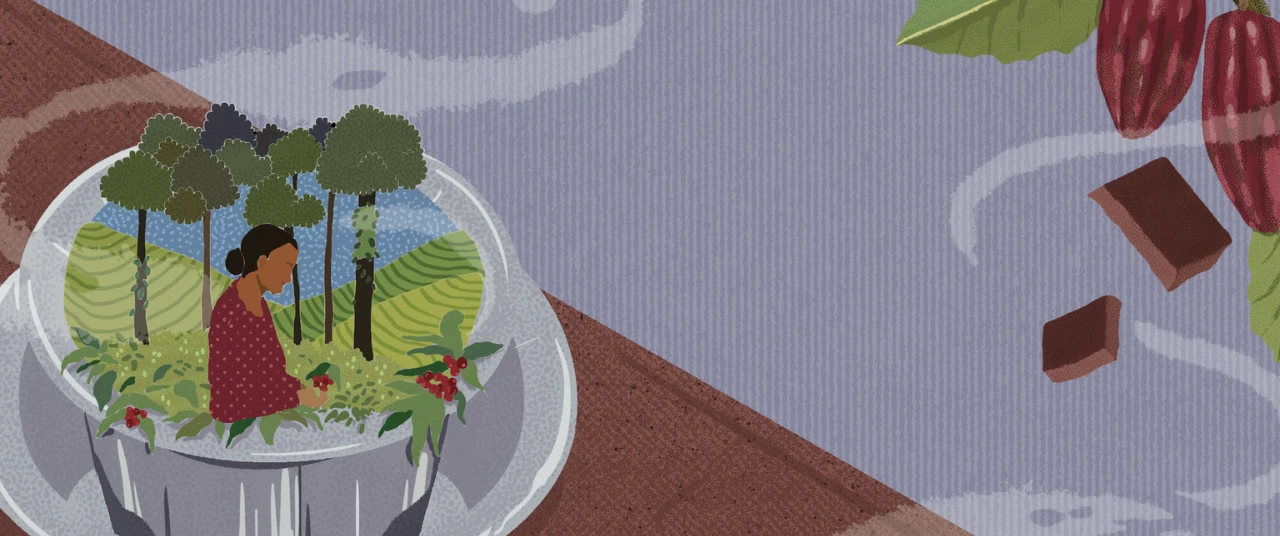Phalguni Ranjan
|
December 23, 2025
|
11
min read
Climate change in my cup: Why India’s cocoa and coffee production is at risk
Erratic rain and rising temperatures affect yield, bean quality and farmers’ willingness to invest
Read More
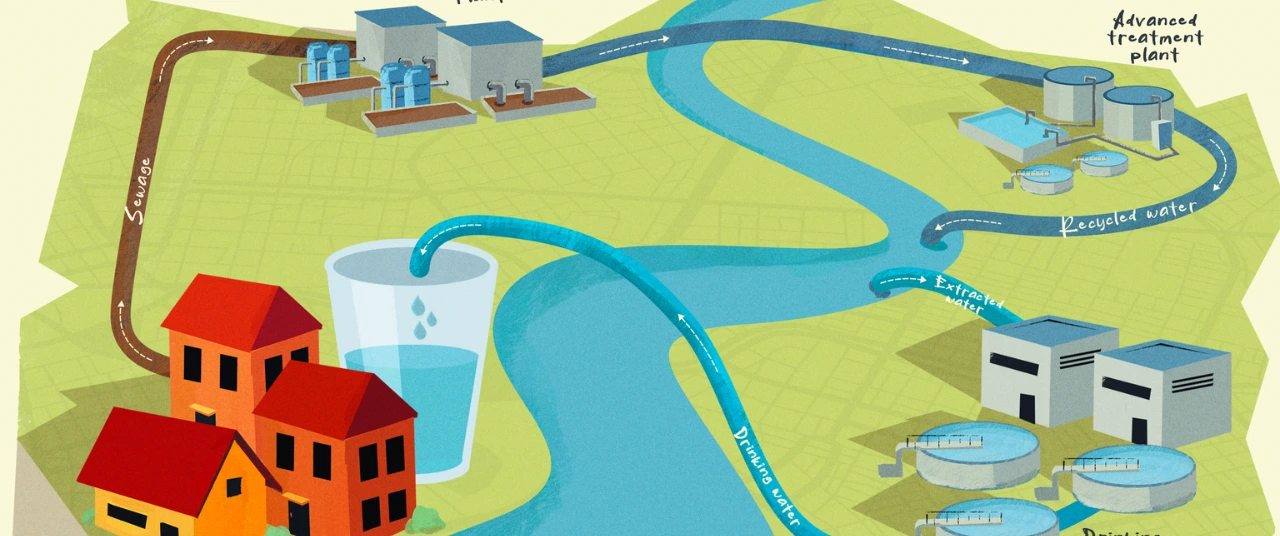
Wastewater can be treated and distilled into a completely safe form. But gaps exist in implementation, public acceptance
Editor’s note: The last two decades have been witness to the rapid and devastating march of unchecked urbanisation and climate change in India’s cities. Among the first victims of this change is freshwater and access to it—from rivers which sustained local ecosystems, to lakes and groundwater which quenched the thirst of residents. In this series, the Good Food Movement examines the everyday realities of neglect and pollution. It documents the vanishing and revival of water bodies, and community action that made a difference.
The sweat on your brow, the dew on a leaf, the droplets lingering on your umbrella—all evaporate, condense into clouds, and return to the Earth as rain. They make themselves at home in rivers, seas, wells, aquifers and the like. Ultimately, they make their way back to you, flowing from the taps you use to wash your face, to the streams you dip your feet into. The story of the water cycle is the story of the oldest, most consistent system of recycling this essential natural resource.
As the 1970s rolled around, the climate crisis really unveiled itself. This is when reusing water became an environmentally conscious thing to do. But long before that, people in Greece, Yemen, and closer home in the Indus Valley had the same idea: they were also connecting homes to drains, and drains to sewers, and sewers to agricultural fields. Such sanitation practices stayed relevant, and in fact, proved all the more important after several water-borne epidemics ravaged parts of the world. In the mid-19th century, for instance, European cities were planned in a way that the urban sewage would drain into nearby agricultural land, aptly named 'sewage farms'. But eventually, the growing density of populations and the increase in human settlements reduced the land available for agriculture, and other avenues had to be found to get rid of wastewater and sewage. Herein emerged septic tanks, contact beds, and trickling filters (the latter two use layers of microbes to filter and clean water) that allowed treated wastewater to be directly fed to freshwater sources.
The return of recycled water is owed to various factors, but it mainly ties into pollution, our depleting groundwater sources, increasingly irregular weather, and the growing fear that we might run out of water.
In the 20th century, these technologies became sophisticated, and one could now recycle large volumes of water in compact spaces. Urban areas spilled into rural ones, and the need to move wastewater to agricultural lands shrunk. The idea of reclaiming nutrients from used water for farming became arcane.
Now, we are inching back towards exploring the potential of recycled water. In late 2019, Chennai launched two Tertiary Treatment Reverse Osmosis (TTRO) plants that purify sewage water to the same quality as raw freshwater. In the town of Devanahalli, Karnataka, thousands have been receiving recycled drinking water since August 2023. In its annual civic budget for 2025-26, the Brihanmumbai Municipal Corporation (BMC) allocated Rs 5,545 crore for constructing seven advanced tertiary treatment plants (ATTPs) in Mumbai, which serve the same purpose.
The return of recycled water is owed to various factors, but it mainly ties into pollution, our depleting groundwater sources, increasingly irregular weather, and the growing fear that we might run out of water.
Also read: Bengaluru is fated to run out of water. When will the crisis hit?
Turn the tap, turn it back. Water gushes and retreats like magic, and we never pause to decode the magician's trick. Where does the water come from? Well, it depends on where you come from. In their paper published in 2015, researchers Mihir Shah and Himanshu Kulkarni proposed a 6 x 4 matrix to understand a city's relationship with its water.
Imagine a city as a cell: we start with a small nucleus (stage I), the centre of development. The cell grows (stage II) and expands (stage III) into suburbs and peri-urban areas. Finally, some cities either expand their boundaries significantly or merge with a satellite city (stage IV). These 4 stages comprise the first axis of this matrix. At each stage, the water supply system morphs and builds upon its former self. While a growing township starts out relying on private wells and borewells, as it grows it formalises into a system of pipelines and tankers.
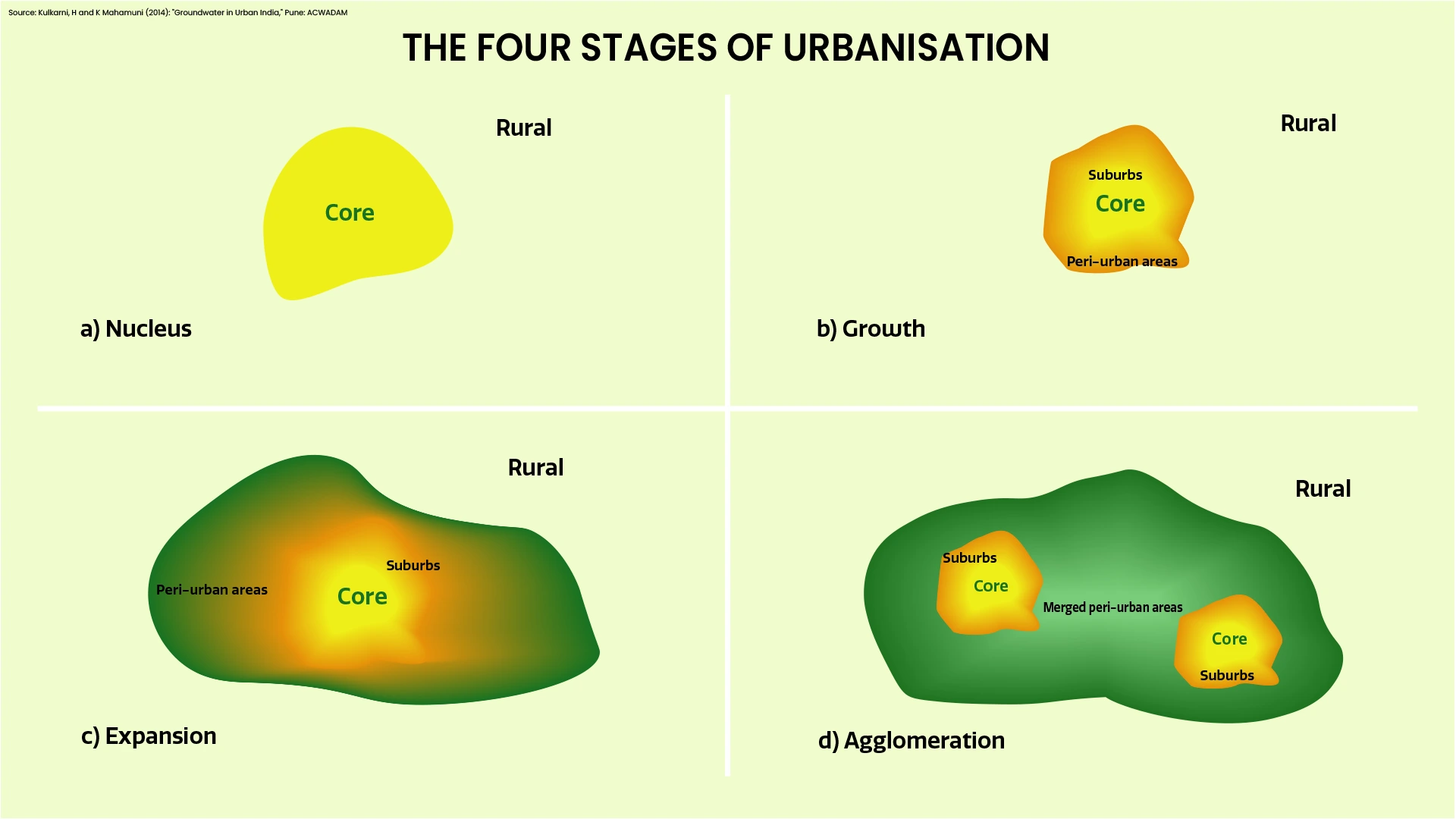
However, water infrastructure in India tends not to catch up with expanding cities. The nucleus continues to receive formally established public water supply, while suburbs tend to source water privately through tankers, and those on the very periphery may continue getting their water from private borewells.
For example, in Bengaluru, large parts of the city receive either Kaveri water or groundwater through the Bangalore Water Supply and Sewerage Board (BWSSB). However, the BWSSB does not yet have a presence in the periphery of the city, where residents instead turn towards private tankers or local borewells. Similarly, one’s socio-economic strata plays a role in water access. A slum's notified or unnotified status dictates its access to BWSSB supplies, even if it is located in an area with the requisite infrastructure.
The other axis of this matrix documents six geological classifications of aquifers—underground layers of rock that can store groundwater, like natural reservoirs—in India based on their quality and capacity to transmit and store water. For example, in the Himalayan ranges, aquifers flow across several villages and towns, while most of south India has crystalline rock that has low storage capacity.
The BWSSB currently has 33 STP plants that treat around 1350 million litres of sewage daily before emptying it into storm water drains.
Ultimately, whether in pipes or through tankers, your water comes from rivers, lakes, or wells fed by rivers and lakes. Once it goes down your drain, this water changes its identity, having now become dirty from the processes of cleaning it was used for. In areas where the municipal sewerage board supplies water, it also takes responsibility for the sewerage—by and large. Apartments over 120 units in BWSSB sewerage networks and apartments over 20 units outside of BWSSB sewerage networks are responsible for installing their own Sewage Treatment Plants or STPs.
The BWSSB currently has 33 STP plants that treat around 1350 million litres of sewage daily before emptying it into storm water drains. Apartments, however, are mandated to reuse the treated wastewater. Predominantly, this water is used for flushing and landscaping. Senior hydrologist at WELL Labs, Shashank Palur, shares that excess recycled water is often illegally discarded into storm water drains, too. However, last year during the water shortage in Bengaluru, the Bangalore Apartments’ Federation (BAF) convinced the Environmental Ministry to allow apartments to offer up to 50% of their treated wastewater on sale, provided that they use the remaining half.
To be fit for gardening and flushing, water undergoes two levels of treatment. At the primary level, machinery is used to break down large particles and then separate out particulate matter through sedimentation. At the secondary level, microbes are used to digest organic contaminants like nitrates. The latter is a dynamic process, requiring constant supervision. "That's where the most maintenance and operational cost is," explains Shashank Palur.
However, there is only so much water that can be used for gardening and flushing. A survey of over 200 apartments by Boson Whitewater found that only 20% of recycled water is used for non-potable purposes. The rest is usually discarded or, if permitted, resold.
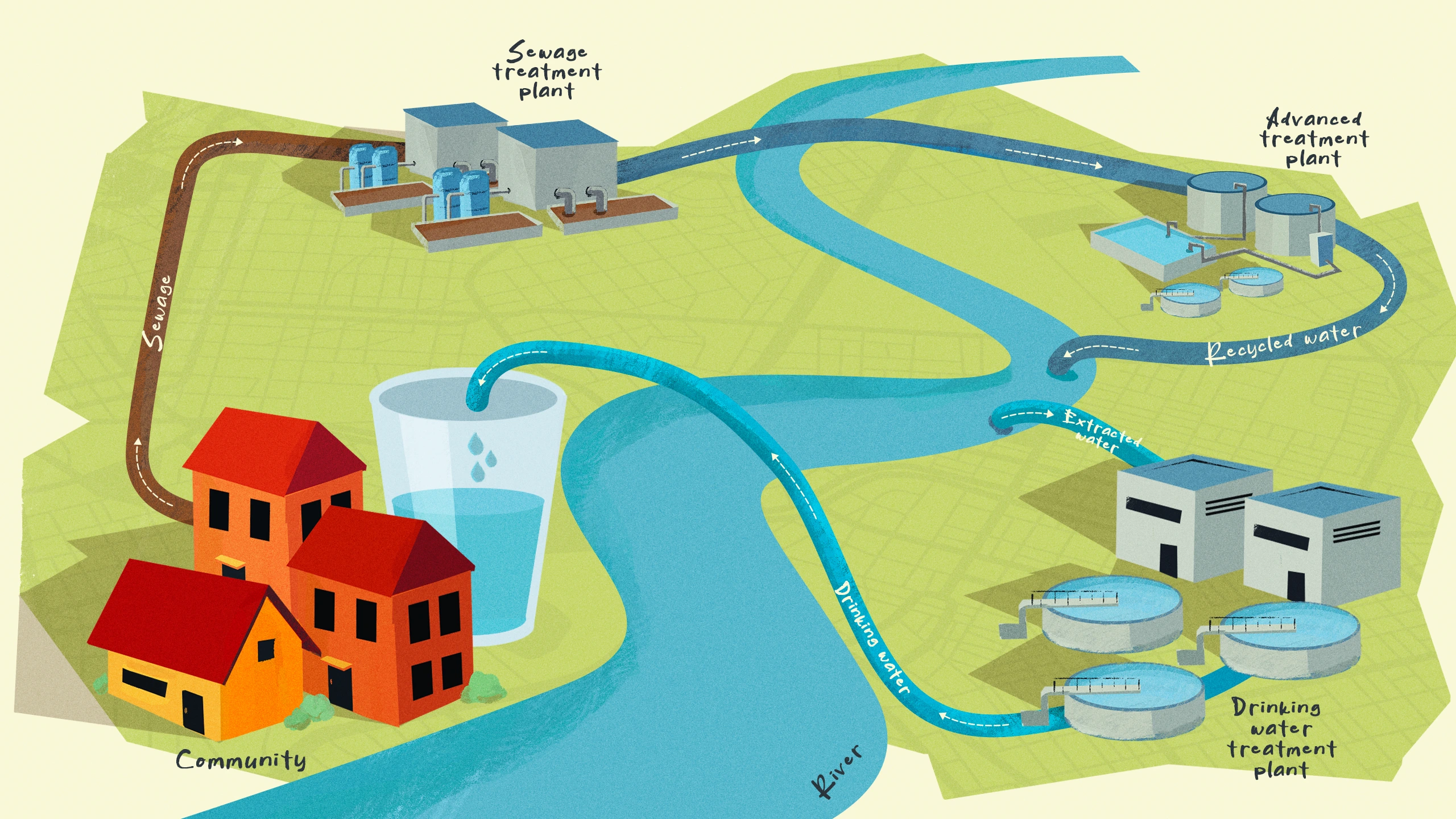
If we want to do more with our wastewater, we need to treat it further. Most STPs set up by apartments are only capable of secondary treatment of wastewater. The next round is cost-intensive, and requires added, trained personnel. Charcoal or sand filters are considered the baseline for any tertiary treatment, but they are often supplemented with reverse osmosis (RO), ultrafiltration (UF), ultraviolet light (UV), and chlorination. Each of these methods target different kinds of impurities, and are often used in conjunction with each other. For example, chlorine and charcoal filters are often paired together in water purification systems. Chlorine effectively removes most bacteria and viruses, but is itself harmful for us in large amounts; charcoal filters effectively remove chemicals like chlorine, thus protecting from the negative byproducts created during the purification process. But the silver bullet of water purification is RO: it removes everything, from viruses to dissolved solids and even the natural minerals of water, resulting, practically, in distilled water. Most RO filters are accompanied by a mineral bed to add back necessary minerals into drinking water.
These internal variations in any tertiary treatment process mean that tertiary treated water cannot automatically be declared potable—it needs to be tested to meet certain requirements and safety standards.
However, public animosity to the idea of treated wastewater comes from more than just the ‘yuck’ factor felt while drinking it.
At the national level, the Union Ministry for Consumer Affairs, Food and Public Distribution sets guidelines through the Bureau of Indian Standards. Currently, two standards pertain to drinking water: IS 10500:2012, and IS 17482:2020. The former pertains to drinking water quality specifications, while the latter covers the management of drinking water supply systems.
The BIS 10500 tests water for 6 physical characteristics, 24 chemicals, and 12 toxic substances. Moreover, water must also be tested for radioactive substances and pesticides. For most parameters there is an acceptable limit for these characteristics, and a permissible limit in the absence of alternate sources. For some parameters, like radioactive substances, there is no relaxation even in the absence of an alternate source. If water quality is below the acceptable limit, then despite the absence of alternate sources, that source should not be used to supply drinking water anymore.
However, the BIS is a standard and not a law. This means that while a conscientious supplier can obtain a certificate proving the quality of water supplied, it cannot be enforced for all suppliers. This lack of enforceability is exacerbated by the fact that water supply is a State subject. While the Centre can nudge the states in a certain direction (as the Jal Jeevan Mission does), it must leave enforcement in the hands of individual states. More recently, the government has also released the draft of the Liquid Wastewater Management Draft (effective from October 2025) which includes expected percentage of wastewater reuse for various kinds of establishments.
Also read: In Gurugram’s rise, a cautionary tale about satellite cities and groundwater
Two roads diverge in a yellow wood, and potable treated water cannot travel both. The choice, in this case, lies between Direct Potable Reuse (DPR), and Indirect Potable Reuse (IPR).
Direct Potable Reuse is when the water goes through primary, secondary, and tertiary treatment and is directly piped into the water supply system after spending a meagre 24 hours in a man-made environmental buffer. As a drought-prone country, Namibia was one of the first countries to embrace direct potable reuse through the Goreangab Water Reclamation Plant in Windhoek. Since its inception in 1968, residents have reported no adverse health effects from the consumption of recycled water. Yet, DPR has had to make way for its more popular sibling, the IPR.
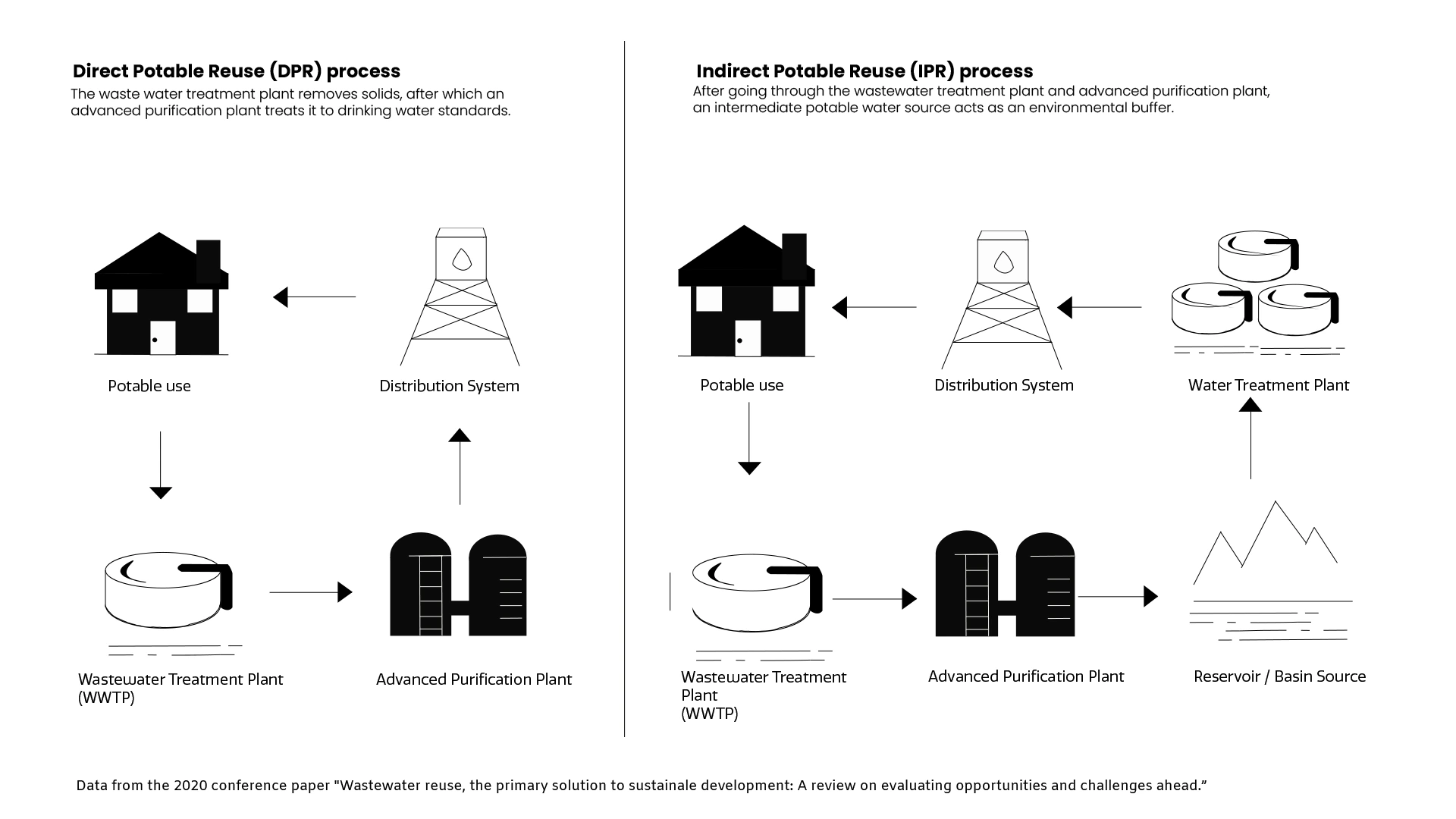
There are different ways to embark on Indirect Potable Reuse, but by definition, they all involve a natural environmental buffer. The idea is to naturalise water by mixing it with sources of ground or surface water, as well as rain. Sewage water supplied by Chennai city is currently emptied into lakes after treatment and then pulled out for water supply. Palur shares how this is, in fact, counterproductive. "It is known that the quality of water right out of the STP is way better than what comes out of the lake, because the lake has some legacy contamination. That's why, again, they have to put up a water treatment plant next to the lake which pumps the water in and then sends it to people."
This extra step is a response to public discomfort with the idea of drinking treated wastewater; most administrators find it easier to placate people by undertaking an additional level of treatment from the environmental buffer rather than attempting to supply treated water directly. This explains why IPR projects are found far more commonly than their DPR counterparts—even though generally, it is more expensive to treat wastewater through this process.
However, the Devanahalli town of Karnataka has found a more purposeful way of undertaking indirect potable reuse. Its municipality has married the causes of recycled water with lake and aquifer rejuvenation. Diluted treated wastewater is first introduced into Bagalur lake, then rediluted in Sihi Neerukere, and lastly diluted by the earth when it enters the well. Then it goes through a water treatment plant before entering the water supply system. However, for such an indirect potable reuse system to work, there is one non-negotiable requirement: clean lakes and wells. The first thing the Devanahalli municipality did was to clean its lakes and wells, such that it can receive treated wastewater and dilute it with clean surface water and rainwater. Now, multiple tests have attested that Devanahalli’s treated water complies with BIS 10500 standards.
This extra step is a response to public discomfort with the idea of drinking treated wastewater; most administrators find it easier to placate people by undertaking an additional level of treatment from the environmental buffer rather than attempting to supply treated water directly.
“The water that the Devanahalli town was supplying to the town before did not meet drinking water standards, because there was no choice. But now, we are making sure that it is meeting drinking water standards,” shares Vishwanath S, director of Biome Environmental Trust, who provided technical knowledge to the Devanahalli town municipal corporation for this project.
Worldwide, across multiple projects, public response has been a big make-or-break factor in treating and consuming treated water. It only makes sense that the WHO 2017 guidelines have a separate section dedicated to ‘The Art of Public Engagement’ with real-life case studies in tow.
However, public animosity to the idea of treated wastewater comes from more than just the ‘yuck’ factor felt while drinking it. There have been, for instance, plenty of reports detailing the emptying of raw sewage into rivers by STPs, instead of treating it. Small semantic adjustments like calling wastewater ‘used water’ can help with this. But the most obscure obstruction is the lack of public trust in the administration to undertake these processes faithfully, transparently, and correctly. Disillusionment with governments in a policy like this can come at the cost of implementation, and many administrators have had to abandon projects like these. Generally, a policy of transparency is recommended where public backlash is anticipated.
This is where Singapore’s NEWater project took the bull by the horns. In 2003, they introduced a water museum, live tours of the factory through a gallery, and got the political leadership to use their packaged water in public.
In all this, it can help to revisit the philosophy of Dr Lukas van Vuure, one of the pioneers on the Windhoek plant, who is remembered for the quote: “Water should be judged by its quality, not by its history.”
Also read: The intertwined fate of Navi Mumbai’s Kolis and the Kasardi river
Cover art by Prabhakaran S
Produced by Nevin Thomas and Neerja Deodhar
{{quiz}}

A farm is more than a patch of land; she is a symphony whose melody may not be apparent to those who only see her functionally
Editor’s note: To know Rama Ranee is to learn about the power of regenerative practices. The yoga therapist, author and biodynamic farmer spent three decades restoring land in Karnataka, envisioning it as a forest farm in harmony with nature. In ‘The Anemane Dispatch’, a monthly column, she shares tales from the fields, reflections on the realities of farming in an unusual terrain, and stories about local ecology gathered through observation, bird watching—and being.
The first monsoon showers dampened the earth, and we took in the enchanting fragrance of plant oils and streptomyces—petrichor and hope (geosmin, a byproduct of the metabolism of the streptomyces bacteria—an indicator of soil health—adds the earthy note to this bouquet of aromas). Raised planting beds were ready with freshly sown seeds. It was like waiting for the curtain to rise on a grand opening, as this was during the early years of biodynamic farming at Anemane. When the mushrooms emerged and mycelium wove across the beds, they brought with them elation—a validation of our efforts to infuse life into starving soil.
Our tryst with the land began in the 1990s. We were faced with the challenge of regenerating soil that had lived as a scrub forest (a thorny forest home to spiny trees, common to the Deccan), converted into arable land, ravaged by granite quarrying and conventional agriculture. It was not merely the physical scars; it was the irrevocable changes to the chemistry and soul—the life spring.
Sixty years ago, burning down bamboo thickets and vegetation did indeed enrich the soil with wood-ash, releasing nutrients like potassium, phosphorus, and calcium, which boosted food production. It was inevitable that the initial supply of nutrients would deplete, increasing soil alkalinity. With denudation and the loss of green cover, there was a decline in organic matter. The unregulated use of chemical fertilisers further degraded the soil. High inputs of urea increased soil acidity, destroying soil biota. Whether it is high levels of alkalinity or acidity, the soil suffers from a reduced capacity to hold water, support life and crops.
Add to this a generous sprinkling of granite dust from the quarries, and what we had was a grey, ashy medium. Granite quarrying only exacerbated the troubles caused by the loss of green cover, and the resultant dust could potentially contaminate groundwater and affect human health.
While the early farmers in Kasaraguppe, where Anemane is located, managed well with inputs of composted dung, tank bed soil (inputs of composted dung and soil from a desilted tank bed rich in organic matter and bio-mass), their sons had to rely more on ‘government gobbara’ (chemical fertilisers) and Green Revolution methods that demanded increasing quantities of chemical inputs.
The mushrooms in our raised plant beds were the opening chords of a symphony—one that came together note by note, quietly, over a decade. They were indicators of the positive change that had we hoped for. Mycelium generally thrive in a more neutral pH soil and in organic matter which they convert into humus, improving the quality of the soil; higher soil organic matter (SOM) meant better porosity. Livingness was taking hold.
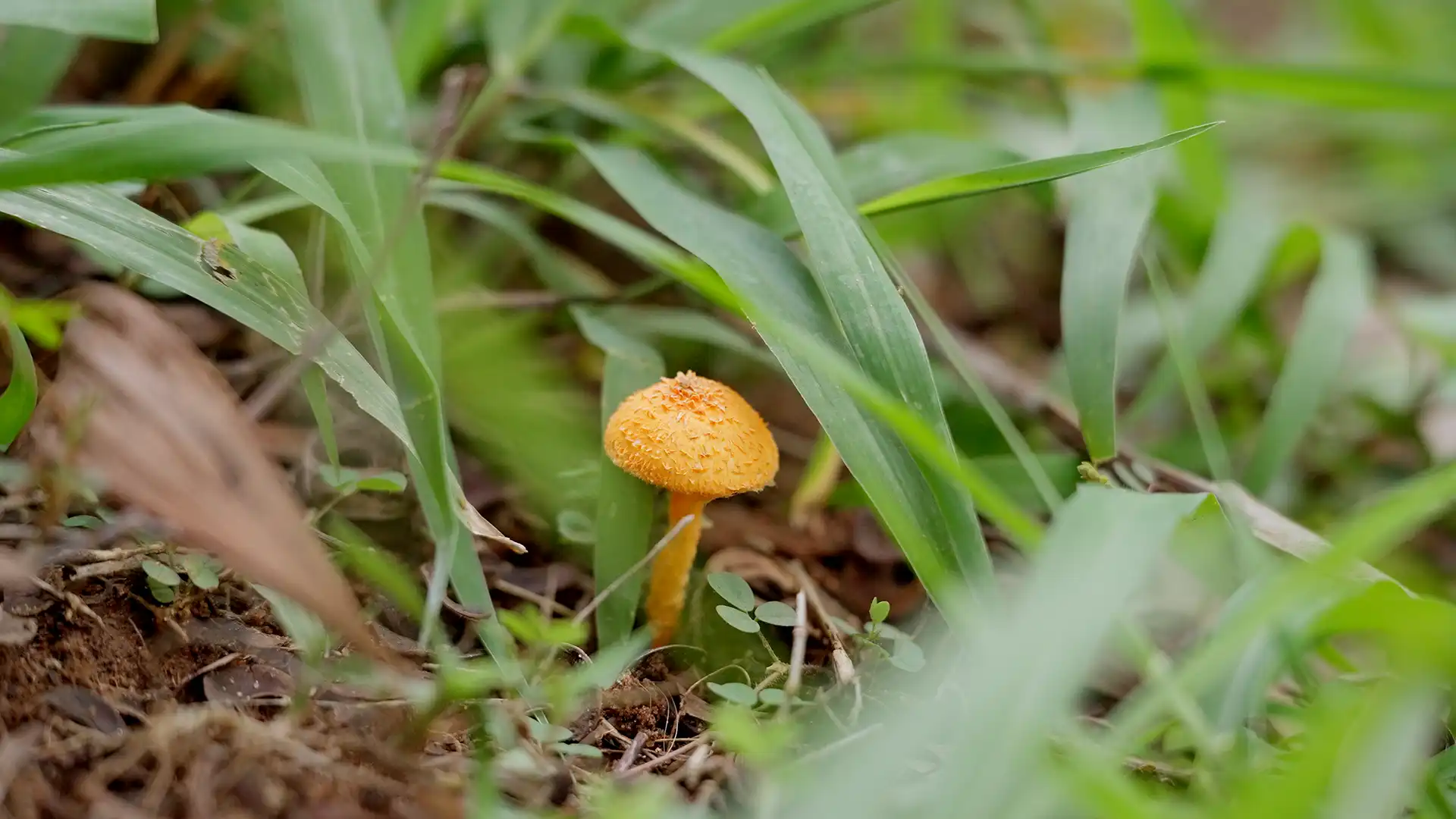
Anemane Farm sits atop a rocky knoll in the Bannerghatta National Park, facing the Suvarnamukhi Hill, with valleys on either side. The undulating land slopes sharply to the east and west, making it susceptible to erosion from wind and rain. The soil depth varies from barely an inch on the hilltop and east, to a few metres in pockets, with a maximum of about six meters in the valley to the east. Measures to prevent erosion were our primary concern.
Tall trees, mainly teak and silver oak, were planted in the interspaces of fields as wind breaks. Close planting made an effective barrier, which was later gradually thinned as the canopies grew wider. While the land had been terraced, there was no vegetation to prevent soil from being washed down the slopes to the west. Contour bunding and planting wind breaks, chiefly local varieties of bamboo and agave like cacti, reduced the impact. The bamboo soon grew into thickets, which made for wonderful homes for babblers, and spur fowls. The cacti seeds, an offering from a friend, were planted much to the disapproval of senior staff member Narasappa, who feared that we were providing shelter to Russell’s vipers. Narasappa was right, but since the cacti were meant to secure the peripheries, no harm was done.

A network of shallow trenches surrounded the fields feeding into larger ones. The bunds were lined with aloe vera and vetiver. Aloe vera, with its shallow and fibrous root system, binds the soil and retains soil moisture, while the leaves store water. Vetiver’s own deep root system conserves soil and promotes infiltration of water. Both are drought-resistant. Fodder grasses, too, contributed to erosion control, lining seepage pits and peripheral trenches.
Trenches were crucial for garnering surface runoff. They served several purposes: top soil carried by the runoff settled at the base as did the water, percolating and gradually recharging the ground water. Leaf litter settled at the bottom turned into a fine compost. The effectiveness of these measures became apparent during periods of drought.
Also read: Farming under the elephant’s nose: Lessons in crop choices
At the deepest point of the valley, which adjoins the forest, there is an open well. It was inspired by a legendary British legacy project that watered vast vineyards and orchards, as well as a water-powered flour mill at Doresanipalya, in south Bengaluru. It simply disappeared after the 1980s, buried in the concrete jungle. Ours was 25 feet in depth and width, a far cry from the 50-feet marvel, as the space and soil type did not permit such extravagance, or did we have a perennial water source. Skilled well-diggers—traditional craftsmen called ‘Mannu Vaddar’ from Punganur, Chittoor—were commissioned. It was lined with hand-dressed stones hewn from the nearly-deserted quarry, perhaps the last project that Perumalappa, the local stone cutter, undertook. The joinery is a work of art!
There was no natural spring to be found. Recharged by ground water from an old pond (Chennammana kunte) upstream, it has a capacity of 2.5 lakh liters, enough to irrigate 2 acres. Incidentally, this transformed the quarry into a deep bowl for harvesting rain water.
.jpg)
Rain-fed dry land is best served by tanks natural or manmade, a lesson to be learned from Kempegowda, the founder of Bengaluru. Historically, tanks meticulously designed and positioned were a part of the city’s primary source, an element of a larger interconnected water system linked to its lakes and rivers, serving various purposes. Stone-lined step tanks or kalyanis are still in evidence in temples. It was logical to design our own cascading chain of tanks to harvest rain water.
A shallow check dam was constructed at an elevated spot where a monsoon-fed stream ran down from the Suvarnamukhi Hll into our land and piped into the abandoned quarry which transformed into a lifeline, with a capacity of about 8 lakh litres—enough to meet our requirement for 8 to 9 months. Further downstream, smaller quarried hollows were bunded and leakages plugged to serve as rock pools.
Pot-drip irrigation, a traditional method using terracotta pots, ensured a weekly supply of 25 to 30 litres per fruit tree—a mix of lemons, pomegranates, and mangoes. This was a method we imbibed from an NGO in a cyclone-prone, water-scarce region in Andhra Pradesh. It was very effective until elephants made a hobby out of smashing the pots!
Also watch: She turned a barren wasteland into a forest farm in Bengaluru
The processes of building soil organic matter and washing chemical residues went together. For seven years, mulch crops like legumes (black and green gram) and leaf litter were integrated into the soil. During this period, locals grazed their goats, fertilising the land. Farmyard manure of goat dung initially sustained the land until Gange and Gauri, our first pair of cows of the Hallikar breed, arrived. Their presence ushered in momentous changes! They were prolific breeders, too. Soon we had Lakshmaiah, a mustachioed man of courage and grit, strong enough to encounter leopards, grazing 10 heads of cattle on the hill.
The absence of any green cover impelled us to plant fast-growing trees. Apart from indigenous varieties like Honge (Pongamia pinnata), Neem (Azadirachta indica), and Maha-neem (Melia dubia), legumes like Senna spectabilis, nitrogen-fixing trees like Agase (Sesbania grandiflora), Gobbarada mara (Gliricidia sepium), and Subabul (Leucaena leucocephala) were grown selectively for green cover, compost, and fodder for cattle. They were useful in regenerating denuded areas. However, proliferation is a threat, and periodic felling and clearing is necessary to maintain a balance. The lopped wood is used to fill up rocky depressions to build up soil organic matter.
Cow dung and urine are the main inputs for enrichment of the soil. Biodynamic compost augments its potential. Cow Pat Pit (CPP), made mainly from cow-dung, is a rich fertiliser particularly beneficial for root growth. Vermicompost in open pits provides a balanced medium for vegetables and potted plants.
Soon we had Lakshmaiah, a mustachioed man of courage and grit, strong enough to encounter leopards, grazing 10 heads of cattle on the hill.
Biodynamic agriculture, developed by Austrian philosopher Rudolf Steiner and based on the wisdom of ancient agricultural practices, offers a unique perspective by highlighting the influence of cosmic bodies and the Earth on nutrient cycles essential for vitality and growth. The farm ecosystem is envisaged as a self-sustaining living being. Nourishing the soil through composting, crop rotation, and other natural methods revitalises the plants, farm animals, humans and indeed, the living environment, enriching biodiversity.
Biodynamic mixed leaf compost combines nitrogenous and carbon-rich materials like green leaves, cow dung and dry leaves in the right proportion, inoculated with microdoses of biodynamic preparations. Decomposed through fermentation, sanitised by the actinomycetes bacteria, and further digested by earthworms, it is ideal for most fruits and vegetables. A host of liquid manures and preparations are made and applied in sync with the Earth and cosmic rhythms. Traditional agriculture offers a range of natural growth promoters, manures, disease- and pest-management measures like Jeevamrutham and Panchagavya which we incorporate in our farming methods.
The boundaries are protected from grazing and clearing, facilitating the regeneration of indigenous flora and habitats. Whenever planting was a necessity, local species were preferred. Wild shrubs and bushes are allowed to grow as hedges in the interspaces of fields, functioning as screens to guard the crops from the prying eyes of peacocks and elephants, integrating them into the farm design. Plants of ethno-botanical importance are conserved.
{{marquee}}
Biodiversity: Stumbling upon a lone Pink Nodding orchid (Geodorum densiflorum) in a rocky patch for the first time was a revelation. Months later, whole clusters were discovered on a moist, leaf-littered slope keeping company with Dead Man’s Fingers (Xylaria polymorpha) under a dense canopy, where it continues to thrive. This terrestrial orchid does occur in the forests of Bannerghatta, but its abundance could imply a revitalised ecosystem—the transition from a disturbed landscape to a more stable, moist deciduous and evergreen type of habitat. The orchid’s symbiotic relationship with endophytic and mycorrhizal fungi indicates their presence, which is possible only in a healthy and balanced ecosystem. In-situ conservation gave them a reprieve from over-exploitation and threat due to habitat loss.
Species richness and abundance are clear signs of regeneration. Three decades ago, there were all of two trees—one Cluster Fig (Ficus Racemosa), and one White Bark Acacia (Vachellia leucophloea). Today, we have a diverse flora of 200 native species, of which 36 are trees. Among them are Jaalari (Shorea roxburghii) and Alale (Terminalia Chebula), climax species and mature guardians of a stable ecosystem. Climax species support high biodiversity and deliver crucial ecosystem services like carbon sequestration, nutrient cycling, and water regulation.
The mushrooms in our raised plant beds were the opening chords of a symphony—one that came together note by note, quietly, over a decade.
The land is blessed with weeds, or ‘children of Mother Earth’ as we call them. They constitute much of our 85 wild edibles, the rest being a mixed basket of shoots, berries, roots and mushrooms, valued for their healing and nourishing properties. A few plants of culinary and medicinal importance, such as Makali beru or Swallow root (Decalepis hamiltonii) are propagated. The Swallow root is significant as this is an endemic and endangered climbing shrub which grows naturally in rocky crevices and is threatened due to loss of habitat and over exploitation.
Rewilding has been instrumental in creating a bridge for larger mammals such as elephants and leopards, and habitats for birds (167 species have been recorded thus far), reptiles, small mammals, as well as a plethora of insects—ants, wasps, and beetles among them, a part of our extended family. Each play a role in sustaining the balance and overall health of the farm.

The Indian Screw tree (Helicteres isora), a deciduous forest species, grows in moist places. These shrubs began to appear with increasing moisture in the valley, possibly through the agency of nectar-loving birds like Purple-rumped Sunbirds of which it is a host. The birds, in turn, pollinate and disperse seeds. Positive relationships such as these augur well for regeneration.
When daily farm-walks began to reveal busy lady bird beetles, jumping spiders and parasitoid wasps clumping earth balls for their nests, and at times whisking away unwary caterpillars; ponds teeming with frogs, snakes and turtles; insect eating birds, and raptors as well, it was clear we had able partners in ‘pest’ management, which made aggressive measures unnecessary. It is an ecosystem service provided naturally in a biodiverse landscape.
Soil: The first signs of soil coming to life are the colour and texture; it has progressively darkened with humus, is moist, loose, and crumbly. It feels slippery to the touch with good aggregation, a beneficial environment for micro- and macro-organisms. Earthworms, once scarce, are everywhere. Fine hyphae interweave with the roots—signs of mycorrhizal fungi. Plants grow deep, strong, and disease-resistant, requiring minimal intervention.
Our fresh produce tastes better and has a longer shelf life. On a bright winter evening in the early years of Anemane, while our sons were rolling in the sand pit, our staff member Maya and her husband proudly offered a bunch of carrots and freshly-harvested spinach—our first attempt at vegetable gardening. The carrots were gnarled and woody, and though we tried to make excuses about the seeds being bad, the spinach was as bitter as neem! Over time, the carrots turned sweeter and looked less like tree barks. And the spinach finally tasted like spinach. By the year 2016, the soil was neutral to slightly acidic, with a pH of 6.68.
Water: A notable change in this decade is that the land sustains low rainfall much better. Drought-related mortality of trees has declined, while the recovery from stress is much better, with fewer casualties even in our orchards. The percolation of groundwater is reflected in the muddy water of the well soon after rains, which gradually turns a milky blue once the silt settles. Summer is always a challenge, but the well sees us through. The borewell shaft, though disused, holds more water than before. While reviewing its viability, the images captured on the camera inserted in the shaft revealed water level at 80 feet, and an inflow from a crevice, possibly a spring, fed by seepage in the fractures. The borewell was declared to be viable and sufficient for domestic use by experts! Earlier, it was abandoned due to low output.
As an extractive industry, agriculture exacerbates climate change and the loss of biodiversity due to high resource inputs (water, energy, and chemicals), deforestation, and emissions of greenhouse gases, methane and carbon dioxide. Gaia, the Earth goddess in Greek mythology, is better served by regenerative practices that are in sync with local conditions and ecology; this is our ethos at Anemane. Our proximity to the Bannerghatta National Park, an endangered scrub forest and a crucial watershed vulnerable to urbanisation, reinforces the need for a conscious, holistic approach.
Over time, the carrots turned sweeter and looked less like tree barks. And the spinach finally tasted like spinach. By the year 2016, the soil was neutral to slightly acidic, with a pH of 6.68.
We are encouraged by changes, subtle or palpable, because they manifest a shift towards a more stable ecosystem that is self-sustaining. The Gaian hypothesis recognises the Earth as a complex living system. The ‘farm-being’ is more than a patch of land. She is a symphony—rich, complex, and sublime. The melody that weaves through her inner processes is not always perceptible to those accustomed to seeing her parts. What we can sense and connect with is her soul, and thereby address the imbalances which affect her.
As eloquently expressed in Animate Earth: Science, Intuition and Gaia by ecologist Stephan Harding, a votary of this hypothesis, “The soul of a place, when entered into with the deep interest and concern that love entails, contains the quality of Gaia as a whole being… We need to give ourselves time to experience the soul of the place and through it the soul of the world, the anima mundi.”
{{quiz}}
Illustration: Artwork by Khyati K
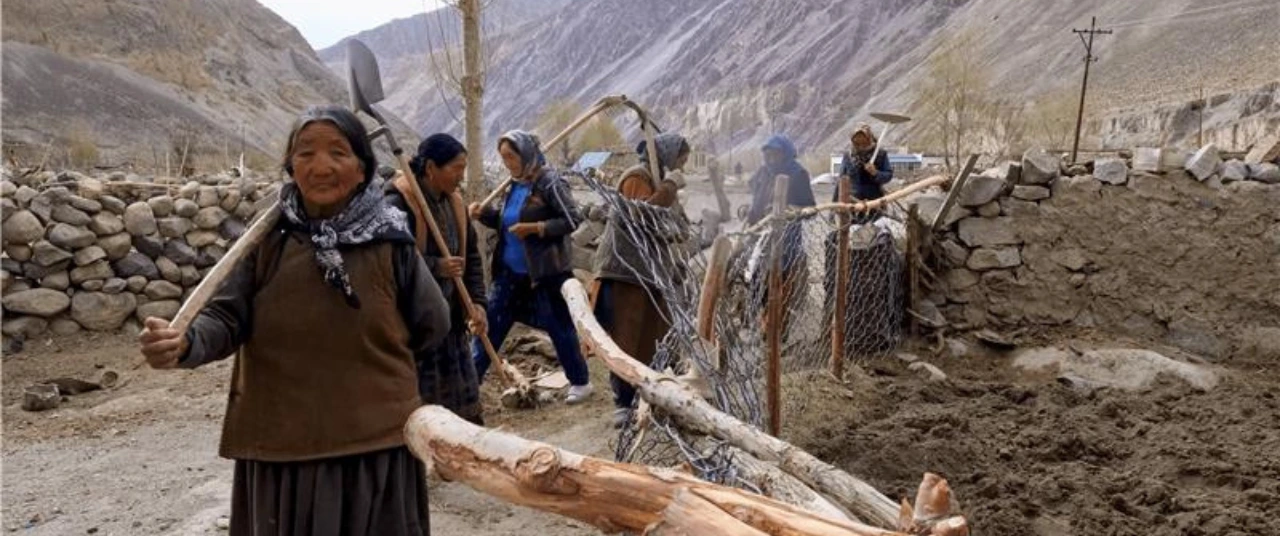
With a more diverse diet, this tight-knit community is able to achieve greater food security in harsh winters
If you were to arrive at Ladakh’s Kesar early in the evening, you’d find the whole village—all of 17 women and a handful of children—seated in a circle on the grey, sandy earth of someone’s backyard, using loose wooden floorboards as mats. You’ll see women in salwar suits and sweaters, wearing scarves over their heads and socks under their slippers. You’ll see a pink-and-white ceramic tray with matching pink-and-white ceramic cups, and a thermos or two of tea. The men of the village live wherever they find employment—mostly in Leh, where they work as drivers. The women stay back, raising children, growing crops, and keeping the village alive.
Kesar village is located on the Changthang Plateau, over 4,000 metres above sea level. It is dry, bitingly cold desert land, barren for most of the year. In the winter months, the mercury plummets to temperatures as low as -30°C. From May to September, there opens a small window of time when the women of the village can grow wheat, barley, and potatoes. This wheat, once it has been harvested and cleaned, is either ground into flour (atta) or dry roasted to make sattu. It serves as their primary food for the rest of the year, weaving itself into their sparse diet: rotis with dal for their main meals, and sattu with their tea. Little else adds colour or variety to their food. For vegetables, they were dependent on a weekly bus to Leh—the closest city, over 180 km away—but they could barely afford it.
The spaces between the layers of polycarbonate trap air, creating air pockets that keep warm air from escaping, maintaining warmth within the greenhouse even in sub-zero temperature winters.
In 2023, the Sher-e-Kashmir University of Agricultural Sciences and Technology (SKUAST, Jammu) introduced polyhouse farming to the region and trained the village women in controlled-environment agriculture. Polyhouses function as advanced greenhouses made of brick walls and plastic roofs; they trap solar radiation and maintain warmth to allow for year-round cultivation of vegetables. The polyhouse in Kesar village features three sides of mud brick walls for improved heat retention, and a triple-layer polycarbonate sheet, chosen for its durability compared to other types of plastics, as well as its ability to diffuse more light than glass. Moreover, to maximise the sunlight received, the polycarbonate sheet typically faces south. The spaces between the layers of polycarbonate trap air, creating air pockets that keep warm air from escaping, maintaining warmth within the greenhouse even in sub-zero temperature winters.
{{marquee}}
Polyhouses have been transformative for the village. While they continue to buy pulses from Leh, they now eat the vegetables they grow. Tsering Lamo, one of Kesar’s residents, talks about how the polyhouses have brought food security—something she didn’t have while growing up. “But now, everything is alright,” she says. “We have vegetables, grains—everything.” The polyhouse has also infused variety into their diet. Instead of living on just dal to accompany their rotis, they now have vegetables. This gives them a reason to cook twice a day, and to find creative ways to incorporate their produce into meals. These vegetables also add new twists to familiar dishes like momos.
The polyhouse has also infused variety into their diet. Instead of living on just dal to accompany their rotis, they now have vegetables.
For miles around, there are only two colours visible: brown and grey. The sky, the mountains, the land—even the sparse vegetation—conform to the palette. The landscape appears majestic and imposing, but also distant and spiritless. The air is suffused with loneliness. In response, a sisterhood has come alive—one that grows food together, cooks together, and eats together. At night, they break off into smaller groups, eating dinner and sleeping over at each other’s houses—living life in an ongoing, alternating sleepover. The polyhouse becomes another weapon in their arsenal; another way to stave off loneliness. Not only are they solving their food problem, but they are also having fun with it, bringing a sense of curiosity, experimentation, and purpose to their time in the polyhouse. They’ve grown not only common polyhouse crops like lettuce, cucumbers and potatoes, but also small watermelons. “This is a newly set-up greenhouse, and we’re slowly figuring out what else we can grow here,” says Tsering Zangmo, with a spark in her eyes.
If you pass them by, the sisterhood will cheerfully call out: “Juley! Juley! Juley!” Juley is used to convey many things—hello, welcome, please, and thank you—with the singular feeling of warmth. The sisterhood of the cold desert thrives.
Also read: Sasbani’s 'fruits' of labour: Reviving hope in rural Uttarakhand
Also read: At Ammachi’s farm, the impossible can be achieved—and made profitable
{{quiz}}

From nutrient imbalance to kidney stress, here’s what happens when your diet contains excess protein
Editor's Note: From grocery lists, to fitness priorities, and even healthy snacking, protein is everywhere—but do we truly understand it? In this series, the Good Food Movement breaks down the science behind this vital macronutrient and its value to the human body. It examines how we absorb protein from the food we consume, how this complex molecule has a role to play in processes like immunity, and the price the Earth pays for our growing protein needs.
Over the last decade, the global food industry has flooded the market with ‘proteinified’ products, heavily capitalising on the widespread belief that we are constantly falling short on the macronutrient. And it’s not just supplements, bars or shakes anymore, people. Those bowing to the fitness holy grail have the option to buy protein-packed ice cream, soda, pasta and even popcorn!
But this surge has less to do with our nutritional needs, and more with clever marketing. As the Wall Street Journal put it back in 2013: “When the box says ‘protein,’ shoppers say ‘I’ll take it’.” This constant messaging that we aren’t eating enough has created a certain ‘protein anxiety’.
Protein is essential for building and repairing tissues. However, consistently consuming it in excess can trigger health issues.
Protein needs do not remain constant over the human lifespan. For the average adult, 0.8-1 gram of protein per kilogram of body weight per day is sufficient. Getting more than 22% of daily calories from protein may do more harm than good. For most adults, about 20–30 grams of protein per meal—or 60–90 grams per day—is enough to stay healthy. Active individuals (especially those doing weight training for more than an hour daily) may need slightly more than this baseline threshold.
Other needs vary more dramatically. Pregnant and lactating women usually need more for bodily repair and growth. Those with chronic illness or inflammation also have greater needs since their bodies use and break down protein faster. Older adults often require more to maintain muscle mass. Ironically, the people who may need that extra bit of protein are not younger gym-goers, even though this is the demographic that most immediately comes to mind when we think of protein-fortified products.
Also read: Is there an ‘ideal’ amount of protein that must be consumed?
Since the body cannot ‘store’ excess protein, it is converted to fat. Unchecked high-protein consumption can cause weight gain. This weight gain is often overlooked in the rush to ‘bulk up,’ but it underscores that more is not always better.
The kidneys and liver play a key role in breaking down and metabolising proteins. When you eat more than the body can use, nitrogen from amino acids is converted into waste products like urea and ammonia. Clearing these requires extra water, putting a strain on the kidneys and raising the risk of dehydration. Early signs include a dry mouth, dark urine, and fatigue. In people with existing kidney disease, this extra load can accelerate decline in function. Foamy or bubbly urine can indicate proteinuria (excess protein in the urine), which is often an early warning of kidney damage.
There are other ways in which protein overwhelms the body’s natural detoxification systems. The liver works harder to process excess protein, leading in rare cases to ‘protein poisoning’ where dangerously high levels of urea and amino acids build up in the blood. While extremely uncommon, it can at times be fatal.
Since the body cannot ‘store’ excess protein, it is converted to fat.
High protein intake—especially from animal sources—can also affect bone health. When protein is broken down, acids are produced in the body. To neutralise this, calcium may be leached from bones, potentially increasing the risk of osteoporosis over the long term. Research suggests that eating less protein may help lower blood ammonia levels and reduce the risk of hepatic encephalopathy—a brain condition caused by the liver not clearing toxins from the blood.
The consequences extend to heart health as well. Long-term high intake of animal protein, particularly red and processed meats, is also linked to a higher risk of cardiovascular disease, partly due to increased saturated fat, cholesterol, and elevated blood lipids. “While there’s no definite link between overall protein intake and risk of death, greater intake of animal protein is associated with a higher risk of death. And plant protein is associated with a lower risk,” says Walter Willett, professor of epidemiology and nutrition at the Harvard T.H. Chan School of Public Health.
Excess protein has also been linked to higher risks of certain cancers, especially colorectal cancer. This may be due to compounds formed when red meat is cooked at high temperatures, as well as the role of insulin-like growth factor 1 (IGF-1), a hormone stimulated by high protein intake that can promote cell proliferation.
Beyond these long-term risks, there are everyday side effects too: bad breath (due to ketones from low-carb, high-protein diets), constipation from reduced fibre intake, and gastrointestinal discomfort like bloating or diarrhoea.
Also read: Is your body low on protein? Signs and impacts of a deficiency
The Indian Council of Medical Research advises against using protein supplements as a shortcut to bulking up. Yet, protein-packed powders, shakes, and bars are often marketed as quick, convenient fixes—promising instant muscle growth, energy boosts, or weight loss. This positioning appeals to anyone looking for a faster route to fitness.
These products are often loaded with sugars, artificial sweeteners and other additives and preservatives that can undermine their supposed benefits. Excessive consumption of protein shakes or bars may also reduce your natural intake of other nutrient-rich foods, leading to a less balanced diet. If you do opt for powders or shakes, look for organic products with minimal additives and third-party safety testing, since supplement regulations are often lenient.
Protein bars, marketed as convenient fuel, can be misleading. Relying solely on them as a main protein source means missing nutrients found in whole foods: omega-3s from fish, magnesium and fibre from beans, healthy fats from nuts, and immune-boosting compounds in seeds. Nutritionists suggest sticking to one, at most two, supplemental protein servings per day—ideally after workouts or on busy days. The rest of your intake should come from varied, natural food sources, rich in amino acids essential to the body.
These products are often loaded with sugars, artificial sweeteners and other additives and preservatives that can undermine their supposed benefits.
When planned properly, Indian meals can be very protein-dense. Instead of processed powders and bars, one can opt for nutritious meals like eggs, beans, and lentil soups that can support long-term health.
Also read: Whey to go: A complete guide on protein
The latest data highlights that Indians are now eating more protein than ever–in urban as well as rural settings. In urban areas, the average person consumed 63.4 grams of protein per day in 2023-24, up from 58.8 grams in 2009-10, an 8% rise. In rural areas, the increase was smaller, from 59.3 grams to 61.8 grams per day.
Protein is essential, but balance matters. Overconsumption can burden the body and deprive you of other vital nutrients.
Protein is essential, but balance matters. Overconsumption can burden the body and deprive you of other vital nutrients. Whole, farm-fresh foods remain the best sources, and professional advice can help tailor intake to individual needs. Ultimately, the right amount depends on lifestyle, age, and health status—reminding us that protein should be seen not as a quick fix or a marketing trend, but as part of a diverse and balanced diet that supports long-term health.
Additional inputs by Harshita Kale
{{quiz}}

Born amid Chennai’s water crisis, this community took matters into their own hands, stirring bureaucrats into action
Editor’s note: The last two decades have been witness to the rapid and devastating march of unchecked urbanisation and climate change in India’s cities. Among the first victims of this change is freshwater and access to it—from rivers which sustained local ecosystems, to lakes and groundwater which quenched the thirst of residents. In this series, the Good Food Movement examines the everyday realities of neglect and pollution. It documents the vanishing and revival of water bodies, and community action that made a difference.
At the end of a 14-year-long stint in the US, in 2012, a 38-year-old techie Sunil Jayaram felt an urge to return to India—more specifically to Chennai, the city he calls home. When he set foot on Indian soil, he could not help but notice how much of urban India was drowning in waste. He was particularly struck by what was unfolding in his own backyard: the Chitlapakkam lake, situated in his neighbourhood, was choked by trash—a result of years of civil and municipal neglect. Alarmed by the decline of a public space he once held dear, Jayaram felt an urgency to act.
Chitlapakkam, a locality in south Chennai located about 25 km from the city centre, is home to nearly 60,000 residents. It urgently needed organised conservation efforts to prevent its lake from degrading beyond revival and vanishing. It all began when Jayaram identified the potential of local WhatsApp groups—meant for sharing cinema updates—to bring people together. The oft-quoted words of social activist and Nobel laureate Kailash Satyarthi, nudging people to act, echoed in his mind.
The movement’s spirit and success is also evidenced by how its neighbouring localities admire and emulate it.
He reached out to two other young Chitlapakkam residents, Udaya Utthandi and Ezhildasan. At first, their intent was focused on small-but-effective interventions: painting walls with anti-littering slogans and urging neighbours to keep bylanes and roads clean. But those small acts soon gathered momentum, growing into wider initiatives like weekend cleanups. Thus, Chitlapakkam Rising—which started a people’s movement—was born in October, 2014. To this day, it remains an active presence on Chennai’s streets and Facebook, serving as a platform for people to voice local, civic issues.
Once comprising all of three founding members, the movement has grown immensely over a decade to thousands of volunteers on the ground and followers online, driven forward by a core team of 50. After six years of consistent organising as well as strengthening the community structure and purpose, the work of the movement began to show strong results and came into the spotlight: in 2019, the Tamil Nadu chief minister earmarked Rs 25 crore for Chitlapakkam Rising’s lake restoration project. In 2024, the lake and Chitlapakkam Rising were awarded the Tamil Nadu Governor’s Award for Environmental Protection; they were recognised for designing a replicable, scalable model for urban freshwater resilience. The movement’s spirit and success is also evidenced by how its neighbouring localities admire and emulate it.
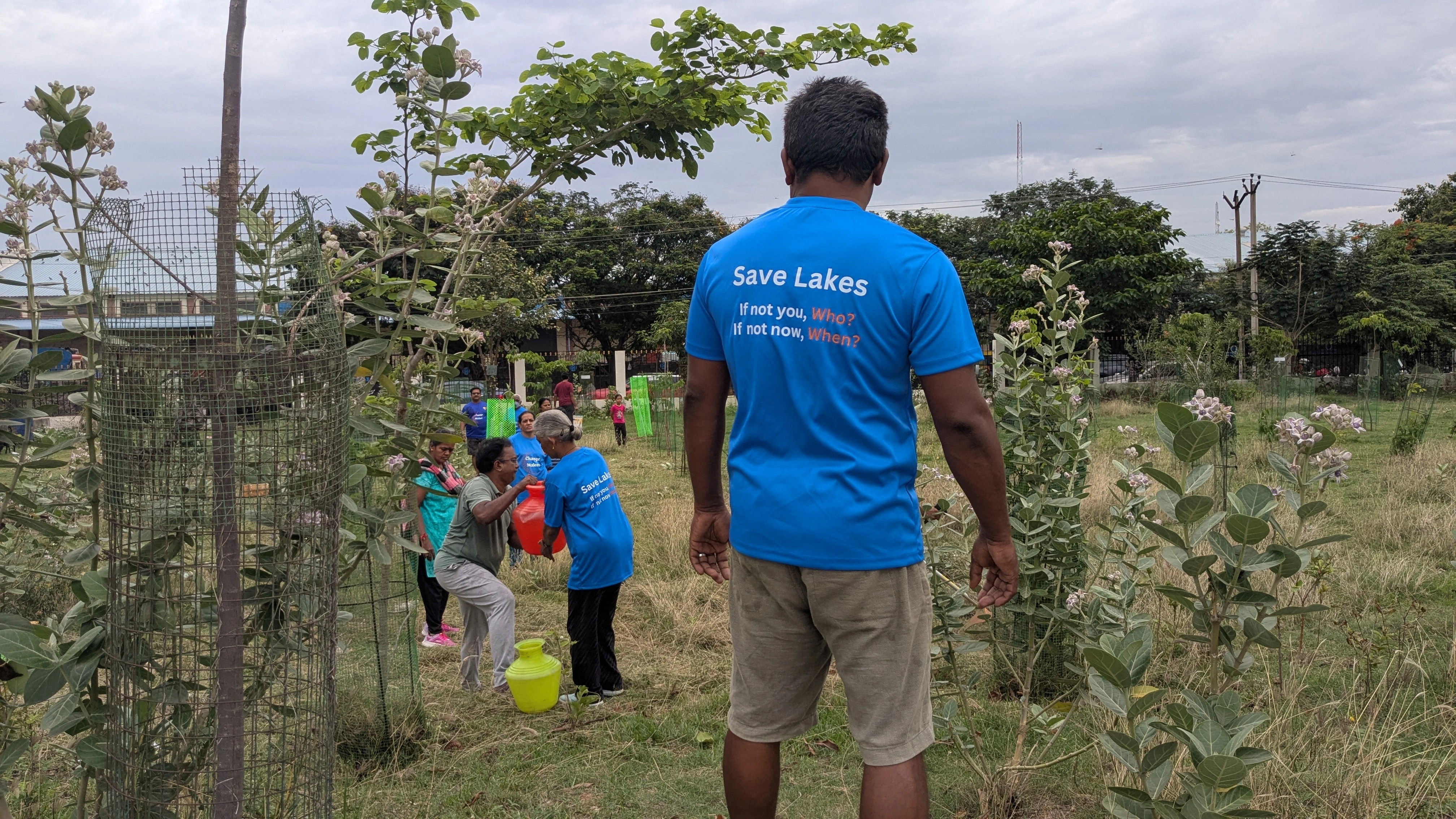
As per the National Water Bodies Census–that surveyed, for the first time, all of India’s water bodies (in 2017-18)–only about 3% of India’s 24 lakh water bodies lie in urban areas. Across the country, metros and Tier 1 cities are fast losing their water heritage. In Chennai, this erosion is especially stark: once home to more than 474 wetland complexes that supported both people and biodiversity, the city has witnessed an 85% decline–over the last three decades–in the area of its wetlands, due to unchecked urbanisation. This loss has critically affected the city’s natural ability to store rainwater, recharge aquifers, prevent floods, and manage climate-related risks.
The 2015 Chennai flood and following droughts exposed the fragility of the city’s water infrastructure, prompting renewed attention from citizens and authorities. Plenty of reports detail just how Chennai’s water bodies have been degraded by encroachment, garbage dumping, untreated sewage, and large-scale development projects; Chitlapakkam lake isn’t an outlier, but rather an example of a troubling civic reality.
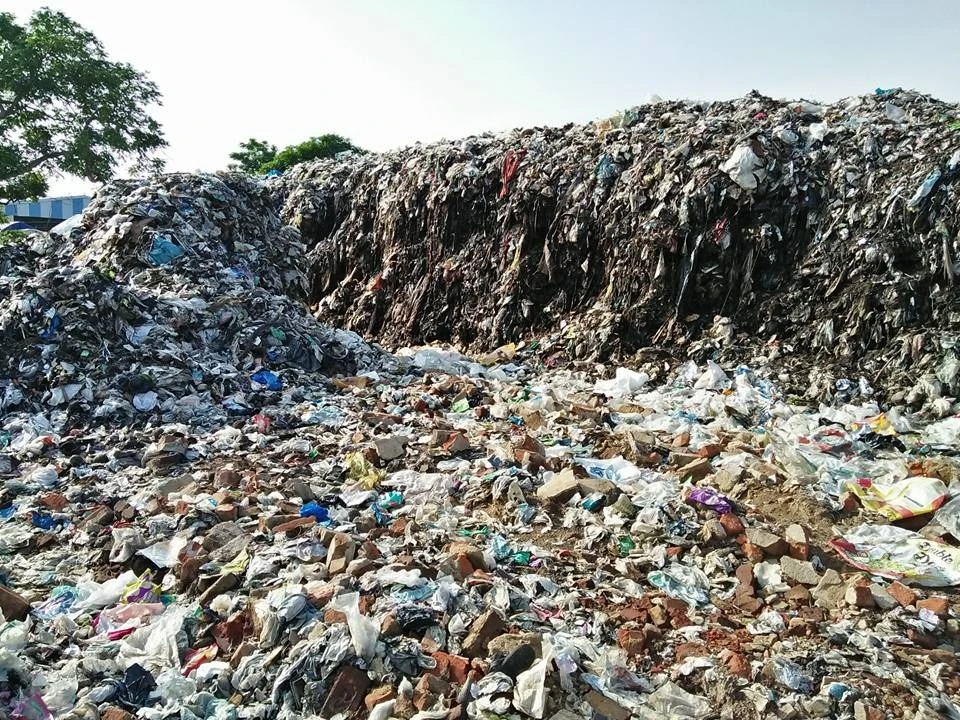
In the early days of Chitlapakkam Rising, the work taken on by the founding members and volunteers involved tasks like cleaning streets and railway stations. The walls of stations were stripped of old posters and transformed with artwork. The nature of these activities attracted locals, inviting them to participate and engage. Soon, the group began to ask itself questions about the state of waste in their neighbourhood: Why was trash spilling out into public spaces? Why was its management failing? Who was responsible for it? These questions gradually shaped their collective journey from straightforward volunteerism to strong, people-driven activism.
In 2018, a catalyst came in the form of a massive garbage mound, piled over 40 feet high, beside the lake. Its stench and spillover loomed over a nearby government school, making everyday life unbearable for children and teachers alike. They reported constant nausea, vomiting, and respiratory issues due to the burning of this waste and foul smells. Even the borewell water drawn from the school grounds was reported to be contaminated. "We had to bring drinking water from outside," recalls retired school teacher Suguna Sampath.
Additionally, access to clean water became a daily struggle. Residents were paying increasing amounts for tanker water, from Rs. 600 to as much as Rs.1,500 for 6,000 litres during summers. "We used to slip into depression, waiting all day for the arrival of tankers," says Sharadha, an active volunteer with Chitlapakkam Rising.
Despite years of petitioning from 2015 to 2019, government action remained elusive—and never focused on Chitlapakkam.
This personal plight was a microcosm of an eventual citywide collapse: in June 2019, Chennai announced “Day Zero”, with all four main reservoirs—Red Hills, Cholavaram, Poondi, and Chembarambakkam—running completely dry. The whole of Chennai, especially Chitlapakkam, was hit hard, as groundwater declined sharply and access to tanker-delivered water became a matter of survival. On this day, 1.1 crore people went without drinking water.
Despite years of petitioning from 2015 to 2019, government action remained elusive—and never focused on Chitlapakkam. It was only when the citizen movement grew and drew larger public attention that the bureaucrats stepped in. "We decided to desilt the lake ourselves. When we did, 1,500-2,000 people joined us. That pressure made the government act," says Jayaram.

The local community was moved to act, even as bureaucratic processes moved at their own pace. Driven by a shared purpose to revive their neighborhood lake and its surroundings, a group of informed and determined residents, including engineers, IT sector workers, climatologists, retired government employees, and homemakers, came together to form a collective that continues to highlight the community’s efforts and spirit. Udayavaani, a civil engineer from the neighbourhood, explains, “The challenges we collectively faced brought us together and after the floods, it became clear that no one was coming to help. We had to take matters into our own hands.”
Social media became a powerful, vital tool during times of crisis, helping the residents to mobilise, put pressure on officials, and draw in volunteers. As a well-informed and closely knit community, they turned to social media to organise, amplify their voices, and demand attention. With relentless posts tagging officials and visual evidence in their hands, the community made it impossible for the government to ignore their plea. As a result, in 2019, the government sanctioned Rs 25 crore under the Water Resources Department (WRD) for the lake’s restoration—a milestone for Chitlapakkam Rising.
The WRD’s Assistant Engineer Narendrakumar, who led the restoration, praises the community’s knowledge and commitment, highlighting that daily petitions poured in not just from groups, but individuals, too.
Also read: Bengaluru is fated to run out of water. When will the crisis hit?
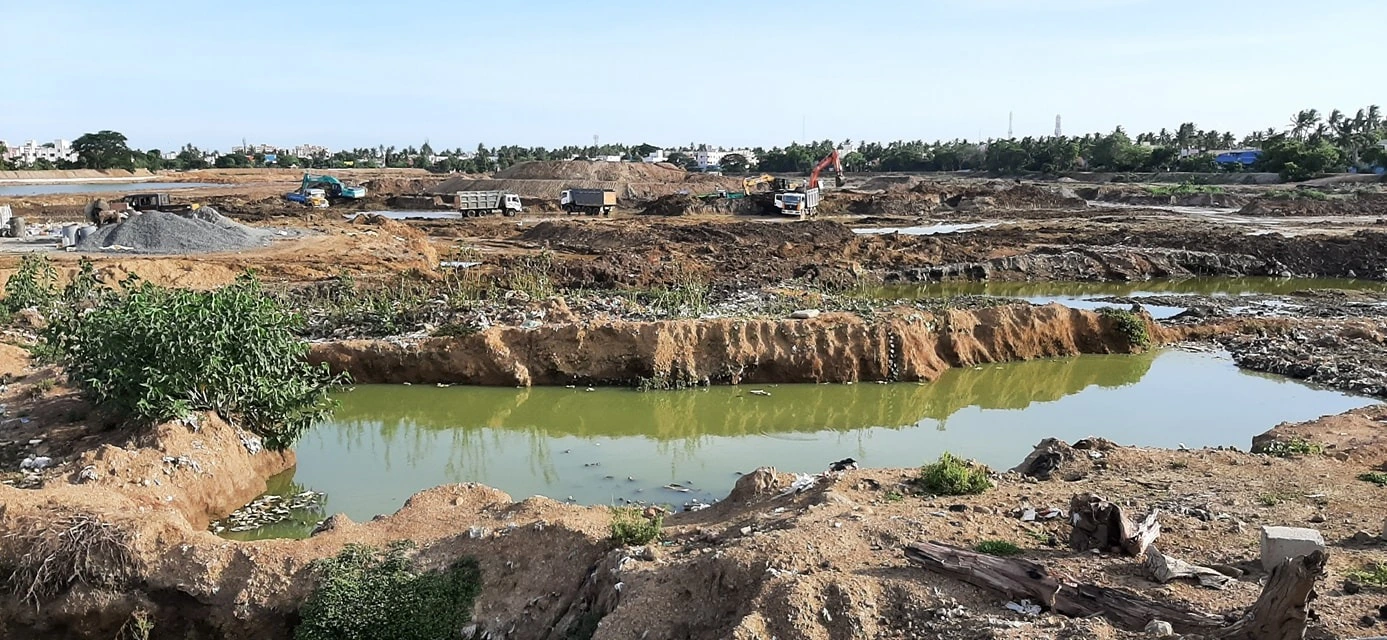
Experts agree that there is no universal approach to restoring water bodies. Each lake or pond has its own set of challenges and must be understood within its specific ecological, social, and cultural context. For this reason, every restoration project begins with a detailed assessment. During this phase, teams study crucial aspects such as water flow patterns, hydrological conditions, and soil quality. Geospatial mapping and climate analysis are also conducted to identify peak water levels and understand seasonal variations.
“Before we began the full-fledged restoration, we decided to approach the problem scientifically,” says Dayanand Krishnan, a civil engineer and a GIS consultant from the community. Many other members–like Krishnan–from the community were mobilised by Chitlapakkam Rising wherever they were needed: for legal processes, political efforts and greening projects. Krishnan, on his end, proposed installing a gate system at all of the lake’s inlets to prevent the entry of sewage water—a first-of-its-kind approach for an urban lake in Tamil Nadu. This would control the inflow and redirect the sewage; a collection well on the southern side of the lake would divert the wastewater away from the main waterbody. The idea was later adopted by the WRD, which eventually designed and implemented the model.
Generally, in urban setups, sewage from homes flows through 6-inch pipelines into manholes, which then transport the waste to pumping stations–essentially, to large underground wells. From there, it is either treated or directed to larger bodies like rivers or lakes.
"The lake was no longer just water storage; it was climate adaptation in action," says Kumaran Ram, a volunteer climatologist involved in the planning.
In the Chitlapakkam model, the lack of visibility in stormwater drains was addressed: when the cover slabs over these drains break or go missing, it becomes difficult to detect whether sewage is mixing with stormwater.
“Another innovation was the way this system helps dry the lake during summers, allowing any residual black water to be drained. This drying period makes it easier to remove siltation. Silt forms a layer that prevents rainwater from percolating into the ground. Think of it like a layer of soap blocking water flow in a bathroom drain; silt does the same to soil, blocking groundwater recharge. By controlling sewage inflow and regularly removing silt, we ensured the lake could breathe again, literally and hydrologically,” says Krishnan.
“Trial pits were dug up to 10 feet to assess soil permeability. Soil samples were tested by PWD labs, confirming that effective recharge was taking place beyond 6 feet. This scientific approach is essential for building climate resilience,” Narendra explains.
Chitlapakkam lake’s original storage capacity was around 7 million cubic feet, but years of neglect had reduced it to just 5 million. The desilting process, along with proper deepening and strengthening of bunds, didn’t just bring the lake back to its former state; they significantly enhanced it. Today, the lake can hold up to 12 million cubic feet of water, storing rainwater during monsoon and supplying it during summer.
For a lake to aid in water conservation and flood mitigation, it must turn dry during summers and absorb water during monsoons, rather than overflowing. The renewed rainwater harvesting capacity in Chitlapakkam was built to withstand 60 cm of rainfall, inching closer to Chennai’s average of 100 cm. "The lake was no longer just water storage; it was climate adaptation in action," says Kumaran Ram, a volunteer climatologist involved in the planning.
Also read: The intertwined fate of Navi Mumbai’s Kolis and the Kasardi river
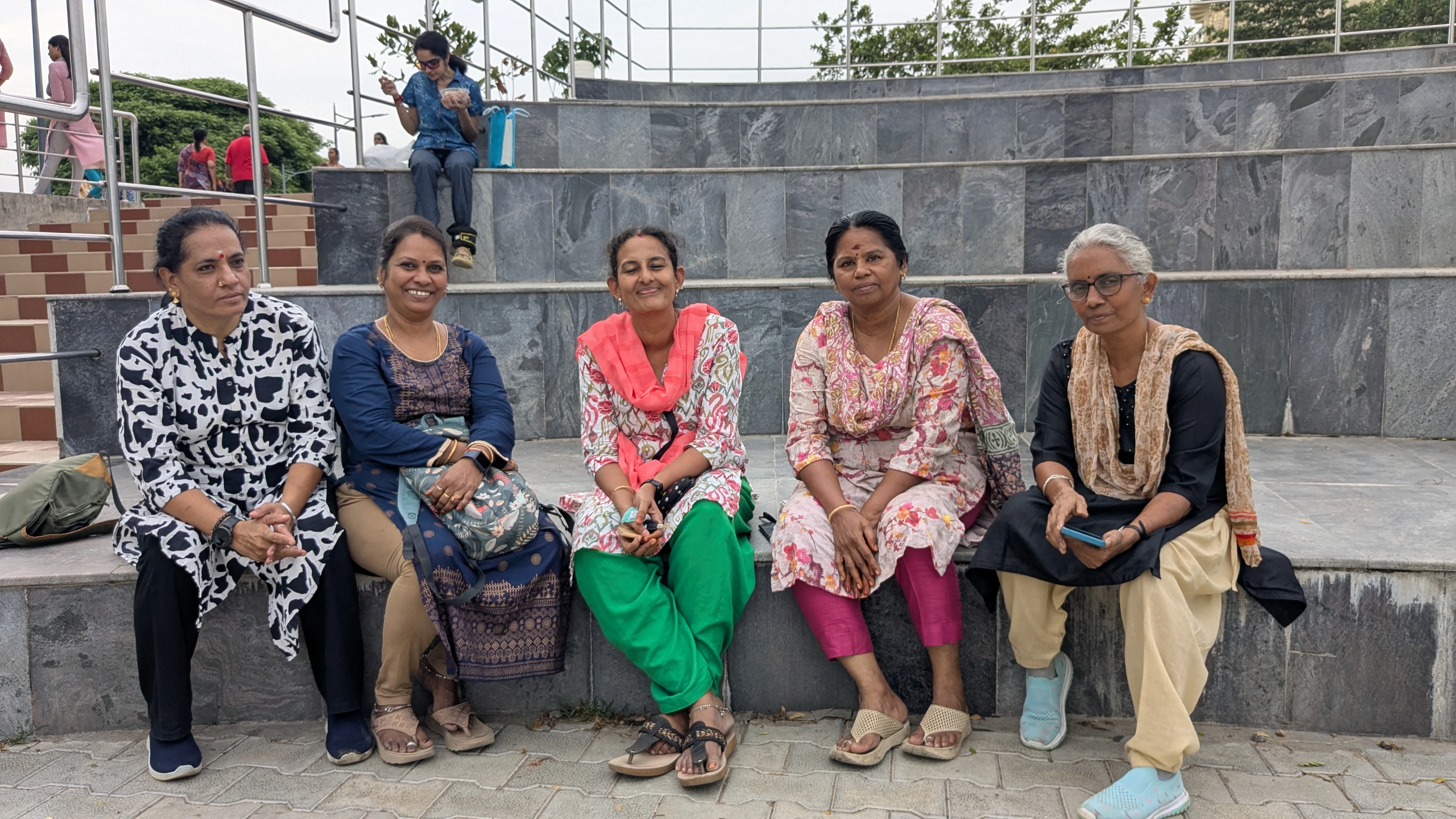
Creating walkways, parks, and pathways around a lake can instill a sense of ownership among the youth. "Other lakes around Chennai have started adopting a similar model," says WRD Assistant Engineer Narendrakumar. Such transformations can fill the community living nearby with pride. “During our early postcard campaigns (a movement circulating informational material, collecting signatures), the children themselves pointed to this dumpyard and collected signatures demanding its removal. Today, as we stand in this transformed space, those memories make the journey feel even more meaningful,” says Udayavaani.
“People once called this area ‘Kuppamettu School’ (a school near a garbage settlement) and ‘Saakada Eri’ (a lake turned into a dumping ground)—names that reminded us of how neglected this place used to be. But now, when someone says Chitlapakkam, they talk about the beautiful lake here, and that change fills me with pride”, says Suguna.
However, the construction of a sewage treatment plant (STP) is yet to be initiated by the local government, which leaves the question of long-term success that lasts generations, unanswered.
Also read: In Gurugram’s rise, a cautionary tale about satellite cities and groundwater

“For any institutional change, classifying all urban water bodies as hydro reserves—akin to reserve forests—would help in their maintenance and make people and governments accountable for any illegal activities taking place in their vicinity,” says Arun Krishnamurthy, the founder of Environmentalist Foundation of India which works across the country for wildlife conservation and habitat restoration. “A multi-stakeholder task force should be created with representatives from the judiciary, government, academia, and local organisations, to keep a check on dying water bodies that can be rejuvenated."
There’s also a need to change public perception: lakes should not be seen merely as recreation zones or flood buffers, but as ecosystems that need biodiversity to thrive. "We all want the lake to be ‘comfortable’ for us. That’s the wrong mindset. Instead, we must think from nature’s perspective," says Ramaswamy, a concerned Chitlapakkam Rising volunteer.
"We all want the lake to be ‘comfortable’ for us. That’s the wrong mindset. Instead, we must think from nature’s perspective," says Ramaswamy, a concerned Chitlapakkam Rising volunteer.
Members of the movement are now extending their support to nearby localities, such as Sembakkam and Nanmangalam, where pressing issues include sewage mixing into the lakes and the rampant growth of water hyacinths, which clog water flow and damage the water table. Alongside their weekly clean-up and maintenance drives within Chitlapakkam, they help other groups by guiding them in filing petitions and raising awareness.
What initially emerged as collective knowledge and learning within one movement, one neighbourhood, has evolved into a sustained, community-driven process—one that thrives on follow-ups, demanding accountability, and a commitment to long-term change. This model of solidarity underscores the power of individuals coming together, not just to clean but to transform. As India faces the escalating twin crises of urban water and waste, the success of Chitlapakkam Rising shows that solutions lie not only in government policy, but also grassroots action. When informed citizens take charge, change becomes not only possible, but inevitable.
Artwork by Prabhakaran S
Edited by Neerja Deodhar and Anushka Mukherjee
Produced by Nevin Thomas and Neerja Deodhar
{{quiz}}

Traditionally, India processed foods through pickling and fermenting. Industrially produced, packaged foods are markedly different
The Plate and the Planet is a monthly column by Dr. Madhura Rao, a food systems researcher and science communicator, exploring the connection between the food on our plates and the future of our planet.
Walk into any grocery store today, and you're likely to find shelves stacked with shiny packets, instant mixes, and colourful snacks that promise taste, speed, and convenience. From breakfast cereals to frozen parathas, ultra-processed foods (UPFs) have become a staple of modern life, especially in urban India. But behind the vibrant packaging and clever marketing lies a more complex story about convenience and its consequences: what exactly are these foods, how did they become so ubiquitous, and what are the effects of their growing presence in our diets?
The term ‘ultra-processed food’ was introduced in 2009 by Brazilian nutrition researcher Carlos Monteiro, who also developed the NOVA classification system. Now widely used in global debates on food and health, this system groups foods into four categories based on the extent to which they have been processed.
At one end are unprocessed or minimally processed foods, such as fresh, dried, frozen or fermented fruits, vegetables, grains, milk, eggs and meat. Next are processed culinary ingredients like oils, ghee, sugar and salt, which are extracted from whole foods and used in cooking. The third category includes processed foods such as cottage industry-produced foods, like papads, pickles, and fried snacks, made by combining foods from the previous two categories. The final category is ultra-processed foods, which are industrial products made mostly with refined ingredients, often with little or no whole food content and with multiple additives. These are designed for convenience and wide appeal, and are usually marketed aggressively. Biscuits, sausages, heat-and-eat meals, vanaspati (hydrogenated vegetable oil), and infant formula are typical examples.
I find that the older colloquial term junk food does a better job of capturing the problem.
The logic behind NOVA is that the more a food is transformed by industrial processes, the more likely it is to contribute to poor health. And there is growing evidence to support this idea. Numerous studies have shown that diets high in UPFs are associated with a greater risk of obesity, heart disease, type 2 diabetes, gastrointestinal issues, and even certain cancers.
However, the term ‘ultra-processed’ and the NOVA categorisation itself, are not without problems. Critics have argued that the problem with UPFs isn’t necessarily how they’re made, but rather their poor nutritional quality: high in sugar, salt, and unhealthy fats, and low in fibre and micronutrients like vitamins and minerals.
A colleague who teaches food engineering recently offered a useful example. He explained that plain yoghurt falls under NOVA category 3, processed foods. But add a swirl of fruit jam or artificial flavour, and it moves to category 4, ultra-processed. The change in processing is minimal. In an industrial setting, it may be as simple as opening an extra valve to add ingredients. Nutritionally, though, the difference is more significant. Flavoured yoghurt often contains added sugar, colour, and other substances that alter its health profile, even if the underlying process remains pretty much the same.
The current wave of industrially produced and packaged foods marks a distinct departure from traditional processing in both method and purpose.
I find that the older colloquial term junk food does a better job of capturing the problem. It points more directly to the nutritional quality of the food, rather than how many industrial steps went into making it. Although a sugary soft drink and packaged buttermilk fall into the same NOVA category, the former is ‘junk’ while the latter is not, owing to their very different nutritional profiles. That said, it is also important to recognise that while processing itself isn’t inherently harmful, industrial food processing often enables and amplifies nutritional risks. The very features that make UPFs appealing—long shelf life, hyper-palatability, and low cost—are achieved by manipulating ingredients in ways that tend to skew their nutritional profiles. In this sense, the process can’t be separated from the product: the way something is made often dictates what kind of food it ends up being. Therefore, for the purpose of this column, I will use ultra-processed foods to describe industrially manufactured unhealthy food products, even as I remain cautious about the limitations of the term.
Also read: Protecting place and power, not people: The trouble with GI tags
Ultra-processed foods have become an increasingly prominent part of the Indian diet in recent decades. While traditional Indian cuisines have always included some forms of processing, such as fermenting, drying, pickling, and roasting, these techniques were typically used for preservation, flavour enhancement, or out of seasonal necessity. The current wave of industrially produced and packaged foods marks a distinct departure from traditional processing in both method and purpose.
Today, ultra-processed foods are available almost everywhere in India, from village shops to railway stations, typically at low price points and in highly portable formats. According to a 2023 WHO report, their retail value jumped from just USD 0.9 billion in 2006 to over USD 37.9 billion by 2019, and they are projected to make up nearly 39% of all processed food sales in the country by 2032. Between 2011 and 2021, chocolate and confectionery accounted for the largest share of retail sales, followed by ready-to-eat foods. Beverages held the third spot for much of the decade, but by 2021 they were overtaken by salty snacks.

A major shift in Indian diets began with the liberalisation of the economy in the early 1990s. The entry of multinational food corporations, along with the rapid growth of domestic food industries, brought a wide range of new products into the market. Instant noodles, processed cheese, mass-manufactured snacks, and breakfast cereals became increasingly common in urban households. Designed for convenience, affordability, and consistency, these foods aligned well with the needs of a population that was becoming more urbanised, time-constrained, and influenced by globalised ideals. As more people moved to cities and more women—typically tasked with cooking and carework—entered the formal workforce, traditional cooking practices became harder to sustain. Packaged foods that required minimal preparation offered a practical solution, while advertising campaigns framed them as modern and aspirational, tapping into middle-class values around hygiene, efficiency, and a globalised lifestyle.
Over the years, UPFs started appearing in school lunchboxes (cold Maggi nostalgia, anyone?), office tiffins, evening snacks, and even festival offerings. Many traditional foods started to be re-engineered for mass production, with ingredients adjusted to suit long-distance transport and extended shelf life. These changes often go unnoticed by consumers, as familiar names and packaging maintain the appearance of tradition, even when the contents and production methods had significantly changed. Brands which began as family-run businesses serving freshly prepared foods to local customers, have expanded into large-scale manufacturers, leveraging their brand value as familiar household names to market packaged versions of their products for mass markets in India and abroad.
Also read: What it takes to feed India’s growing cities
While most research and debates on UPFs have focused on health risks, their environmental impact is increasingly coming into view. UPFs rely heavily on a narrow set of monoculture crops like maize, soy, wheat, and oil palm, that reduce biodiversity, degrade soil, and pollute water. Animal-based UPFs often depend on intensive livestock systems that contribute to deforestation and carbon emissions. Beyond farming, UPFs require energy-intensive industrial processing, extensive plastic packaging, and long-distance transport, all of which add to their environmental footprint. Yet most assessments overlook these broader ecological costs, focusing only on farm-level production.
Multinational food corporations also often engage in greenwashing. For example, a snack may be advertised as ‘eco-friendly’ because of its packaging, while its large scale and cheap production was enabled by energy-intensive processing or extractive use of natural resources.

In India, the conversation about regulating ultra-processed foods is a very recent one. The Food Safety and Standards Authority of India (FSSAI) has yet to introduce regulations that directly address the marketing, composition, or availability of UPFs. For a long time, the absence of formal definitions was cited as a reason for inaction. That changed recently when in 2024, the Indian Council for Medical Research (ICMR) and the National Institute of Nutrition (NIN) released updated dietary guidelines. These guidelines offer a clear definition for UPFs and link their consumption to rising rates of obesity, diabetes, heart disease, and other non-communicable illnesses. Public health experts have since called for immediate regulatory action.
UPFs rely heavily on a narrow set of monoculture crops like maize, soy, wheat, and oil palm, that reduce biodiversity, degrade soil, and pollute water.
The same guideline also introduced ‘HFSS foods’, a category referring to products high in fat, sugar, or salt. Public health groups are now pressing the FSSAI to strengthen front-of-pack labelling by requiring warnings on HFSS products. Since most packaged foods high in fat, salt, or sugar are also ultra-processed, this approach could serve as a first step toward meaningful UPF regulation. Yet progress has been slow. The FSSAI missed its July 1 deadline for updating food labelling rules, and the Supreme Court has given the regulator three more months to submit recommendations.
In many other countries like Chile, Peru, Brazil, the UK, and South Africa, governments have introduced fiscal and regulatory measures such as taxing UPFs, restricting their marketing, and mandating warning labels. Most of these strategies aim to shift consumer behaviour, operating on the assumption that food choices are largely a matter of willpower or awareness. While such measures have had some impact, UPF consumption remains a significant public health challenge worldwide. India should take note of these limitations and proceed with caution as the country’s food regulators move to rein in the spread of UPFs.
In most Indian homes, the responsibility for daily cooking, grocery shopping, and meal planning still falls largely on women. Even as more women take on paid work outside the home, they continue to manage the bulk of tasks related to feeding the family. The rise of UPFs has not eliminated this burden, but it has made it more manageable. Instant mixes, packaged snacks, and ready-to-eat products have allowed many women to meet their family’s food needs while juggling long hours of work and other domestic obligations. If UPF consumption is discouraged without offering affordable, time-saving, and nutritious alternatives, the burden of daily food preparation could intensify; falling disproportionately on women and deepening existing gender inequities. Blanket labelling of all ultra-processed foods as harmful risks unfairly confusing consumers and adding to the cognitive burden of preparing meals that are both nutritious and time-saving.
If UPF consumption is discouraged without offering affordable, time-saving, and nutritious alternatives, the burden of daily food preparation could intensify; falling disproportionately on women and deepening existing gender inequities.
If the negative health impacts of UPF consumption are to be addressed meaningfully, corporate accountability must be central to the reform. In many developing countries with weak regulatory frameworks and unchecked privatisation, multinational food companies often sell products of significantly lower nutritional quality than those marketed in higher-income countries. To prevent this disparity, governments must intervene and make it mandatory for manufacturers to meet strict nutritional standards. Setting upper limits on salt, sugar, and saturated fat, requiring full disclosure of ingredients, and restricting the marketing of unhealthy products would help shift the burden of responsibility from individual consumers to the corporations that shape the food environment.
At the same time, the state has a vital role to play in expanding access to healthier alternatives through public infrastructure. Strengthening schemes such as the mid-day meal programme, anganwadi services, and meals served in public institutions can improve access to nutritious, minimally processed food. These initiatives should be designed not only to meet dietary requirements but also to reflect cultural food practices and ensure that healthy eating is both accessible and acceptable across diverse communities.
Yes, but not just about the foods themselves. The real concern lies in the larger systems that make ultra-processed foods so widespread in the first place. Addressing their health and environmental risks means going beyond personal choice to rethink food policy, corporate accountability, and the unequal conditions under which people make food-related decisions. A healthier future will require not only changing what’s on our plates, but also reshaping the structures that decide what ends up there.
Artwork by Alia Sinha
Also read: The promises—and perils—of Indian aquaculture
{{quiz}}

Lack of adequate nutrition increases vulnerability to TB and prolongs recovery from it
At a government-run tuberculosis (TB) hospital in Mumbai’s Malad suburb, 29-year-old Usha and her mother wait patiently for their turn to get medicines. Uma, who is 50, was diagnosed with Drug-Resistant Tuberculosis (DR-TB) a week ago at a private clinic. She wears a weary look on her face.
"I have been coming to this hospital for three days for these medicines, leaving my work aside—with no doctor in sight. My mother's condition has worsened over a week, with a persistent cough and fever due to delayed treatment," Usha says.
At another government-run hospital in the nearby suburb of Kandivali, frail-looking, 40-year-old Ashok—the sole breadwinner of his family of three—waits. Diagnosed with TB nearly seven years ago, he now fears a relapse. “I was coughing heavily and unable to breathe when I was first diagnosed. I completed my treatment and recovered, but recently, I have begun experiencing chest pains again and fear that a relapse is imminent."
In 2018, the Government of India launched the Nikshay Poshan Yojana to provide monthly monetary assistance of Rs. 500 to TB patients for adequate nutrition through centralised Direct Benefit Transfers (DBT). The amount of the aid was raised to Rs. 1,000 earlier this year. At the time of the scheme’s launch, Ashok—the resident of a small tenement in Mumbai—didn’t reap any of its benefits because he was unaware about the Yojana. And though he received timely medication from the government hospital, managing his nutrition as per the doctor’s advice was challenging, as both his wife and son depended on him. He believes that the government should provide sufficient financial assistance and rations to patients suffering from the disease.
Globally, India leads in DR-TB with 1,35,000 cases of MDR/RR TB annually due to a lack of rapid diagnoses in low-resource settings, posing a significant constraint on DR-TB treatment.
Many vulnerable socio-economic populations in India, especially informal and migrant workers, are unable to afford the luxury of rest and proper nutrition without remaining reliant on daily wage work. This is despite schemes like the Nikshay Poshan Yojana, as patients in need remain unaware about their provision.
The United Nations defines TB as a bacterial infection primarily affecting the lungs, but it can also affect the brain and spine. It is caused by the Mycobacterium tuberculosis bacteria. The World Health Organization states that India has the highest number of TB cases worldwide; the country reported 26.07 lakh tuberculosis cases in 2024, with Uttar Pradesh reporting the highest cases at 6,81,779, followed by Maharashtra at 2.25 lakh cases. Mumbai contributed 60,051 cases to the state's numbers in 2024.
The death rate from multidrug-resistant TB (MDR-TB), specifically, hovers around 20% in India—higher than the global average of 17%. These figures depict dire on-ground realities; for context, the National Tuberculosis Elimination Programme (NTEP) aimed to eradicate TB by 2025, five years ahead of the Sustainable Development Goals (SDGs) target of 2030.
| Types of DR-TB | |
|---|---|
| Mono-resistance | Resistance to a single first-line anti-TB drug (medication which is given when TB bacteria is susceptible to the medicine) |
| Poly-resistance | Resistance to more than one first-line drug, excluding both isoniazid and rifampicin |
| MDR-TB | Resistance to both isoniazid and rifampicin |
| XDR-TB | MDR-TB plus resistance to a fluoroquinolone and at least one of the second-line (drugs used when resistance is developed to first-line drugs, or when patients cannot tolerate them) injectable drugs, such as kanamycin, amikacin, or capreomycin |
The different types of DR-TB are mono-resistant, poly-resistant, MDR-TB, and extensively drug-resistant TB (XDR-TB). Around 3.2% of new DR-TB cases are MDR-TB/rifampicin-resistant—they resist first-line drugs, or the first round of drugs that is administered when the bacteria still responds to medication. When the bacteria resists this first round, like in the case of DR-TB, the infection is fought with a different combination of medicines: second-line drugs, which can be more toxic, more expensive and less effective.
Globally, India leads in DR-TB with 1,35,000 cases of MDR/RR TB annually due to a lack of rapid diagnoses in low-resource settings, posing a significant constraint on DR-TB treatment. As a result, it is estimated that around 56% of MDR-TB cases remain undiagnosed in India.
The WHO guidelines recommend using rapid molecular tests like GeneXpert to diagnose DR-TB instantly, offering detection in less than two hours, compared to conventional culture-based methods, taking several days or weeks. However, these services are scarce in the rural hinterlands of India, especially the Northern states.
Only one in three DR-TB patients worldwide receive high-quality care, the WHO notes. In India, which contributes over 27% of global cases, DR-TB presents a significant public health problem, as patients often require changes in their treatment plans, usually linked to poor treatment adherence in peripheral and resource-limited zones. Drug-resistant tuberculosis cases increased by 36% in Mumbai between 2015 and 2017.
In 2022, the WHO recommended using a shorter six-month regimen called BPalM, consisting of four drugs, to treat DR-TB—compared to the standard 18-24 month regimen—as it has a global success rate of 85%. This positive statistic comes with better treatment outcomes, reduced mortality rates and less infectiousness in recovery. BPalM is also significantly more cost-effective—and the reduced treatment costs ensures more access to patients.
However, India has adopted this regimen conditionally, and private practitioners don't have access to prevent its misuse. In Mumbai, a hotspot for drug-resistant TB, only 144 patients have been given the BPalM regimen this year on a pilot basis.

Also read: Antibiotic overuse is turning your gut against you
There are several types of TB. It can be inactive (latent TB): the infected individual does not have symptoms and cannot spread the infection, which is suppressed by treatment. It can be active: the infected individual can spread the infection through droplets in the air.
Active TB can be treated and even cured, but it is a particular kind of active TB that scares doctors and patients alike: the forms that are drug-resistant, meaning one or more anti-TB drugs administered to the patient show no effect on the bacteria. It fights back.
Dr. Indu Bubna, a Mumbai-based pulmonologist with over 20 years of experience, says, "DR-TB is a form of TB that does not respond to the primary anti-TB drugs, particularly isoniazid, and rifampicin because of incomplete or incorrect treatment. DR-TB is more toxic and requires lengthier treatment." According to Dr Bubna, the challenge emerges when a patient is diagnosed with XDR-TB (extensive drug-resistant TB)—a more severe form of DR TB—making the case more complex with the failure of second-line drugs.
Though India is widely considered the ‘pharmacy of the world’, TB patients in the country suffer due to the lack of medicines.
"In India, before visiting a government Directly Observed Treatment (DOT) centre, patients tend to self-medicate, delaying diagnosis. Often, treatment is started based on X-rays without the appropriate tests because of strained finances," Dr Bubna adds. Drug shortages during the patient's treatment can also cause interruption, making the disease more resistant.
TB is known as the "disease of poverty" because the chances of contracting it are furthered by factors such as malnourishment as well as the lack of air and sunlight in cramped residences. An airborne disease, it is caused only by inhaling infectious droplets from the air. TB is not caused by any changes in diet, or anything in the water, but these are still really important factors in the context of the disease. Malnutrition renders the immune system weak; a malnourished person is more at risk to get infected by TB—in fact, it increases the risk by 13.8% per unit decrease in the body mass index (BMI). The body’s ability to respond to treatment is severely affected, as poor nutrition can prolong recovery. Moreover, some people develop resistance to TB over time, and this can be due to the lack of access to proper nutrition and prescribed, timely dosages.
Malnourishment is also a risk factor in converting latent TB to active TB, and this weakness in immunity also makes patients less likely to recover once they do contract the disease.
Dr Bubna points out that the incidence of TB is now increasing in the middle and higher income sections of India’s population as a result of one specific reason: these sections follow rigid, traditional diet regimens that are often lacking in nutrition. "TB is not just about malnourishment—it also manifests in patients who don't eat food on time and travel in overcrowded spaces. Furthermore, people with HIV, diabetes and those who indulge in drug abuse are also vulnerable," says Dr Bubna.
Malnutrition renders the immune system weak; a malnourished person is more at risk to get infected by TB—in fact, it increases the risk by 13.8% per unit decrease in the body mass index (BMI).
The prevalence of TB can be linked clearly to a lack of access to nutrition as well as a flawed approach to nutrition. Dr. Bubna explains, “While the Public Distribution System (PDS) and mid-day meal programs provide calories and iron-fortified staples like rice and atta, these diets often lack adequate protein and key micronutrients. Protein is especially important because it helps rebuild tissues, strengthen muscles, and restore immune function. Micronutrients such as zinc, vitamin D, vitamin A, and B-complex vitamins are also vital for immune defense and healing, but these are often missing in the diets of TB patients.” The gap lies in the difference between calorie sufficiency and nutrient adequacy: patients often get food that satiates hunger, but does not provide the quality of nutrition required for faster recovery and reduced relapse risk.
"In India, most people lack either vitamins B12 and D, or protein,” Dr. Bubna points out. This is also reflected in the burden of disease that India carries: we account for around 27% of TB cases across the world. A well-balanced diet rich in proteins and vitamins, like iron, zinc, B12, and D3, is essential for patients battling DR-TB. Addressing TB care's social and nutritional loop is essential for its elimination.
According to government data, over Rs. 3,200 crore have been disbursed to 1.13 crore TB patients under the Nikshay Poshan Yojana; the government has committed another Rs. 1,040 crores as a 60:40 divide between the centre and states, under the same programme.
The unaffordability of nutrition is a concern for several patients in India. Even with low prices, a healthy diet remains out of reach for nearly 74% of Indians, according to a UN agency report. "Doctor sensitivity also plays a crucial role in wholesome counselling. Without that, the prescription is never complete. Every TB patient should have a protein and iron-rich diet, comprising green leafy vegetables, one fruit, paneer, soya, and several proteins, because they have a high risk of relapse and mortality for DR-TB."
Also read: The warning about antibiotics we should have heeded

To improve diagnostic services, says Dr. Bubna, governments must decentralise testing, improve sample transport, and integrate private labs into the national network—changes that are underway in Mumbai. However, India’s more remote centres lack even basic tests like the Line Probe Assay (LPA), a quick molecular test that presents results within 24–48 hours.
Screening and testing for TB early and accurately is extremely crucial to treatment and recovery from this infection, and there are multiple provisions in place for this. In 2012, the Government of India made TB notification mandatory for both public and private sector healthcare providers. In 2017, the Government of India announced a National Strategic Plan (NSP) to eliminate TB, and set aside a budget specifically for testing. The very next year, the Ministry of Health and Family Welfare issued another order stating that doctors, pharmacists, chemists, and laboratory staff could face jail time if they fail to notify TB cases.
Despite these stringent rules, India contributes approximately 25% of “missing” TB cases globally, as the WHO estimates that approximately 1 million TB cases in India are not recorded annually. A detailed report from IndiaSpend reveals that while the NSP aimed to spend funds on diagnostic equipment, testing kits, and increasing testing in the private sector, they only spent “2.1% of [their] budget (Rs 4.34 billion) on diagnostics up to 2023-24.” While the 100-day campaign to eradicate TB introduced by the centre in 2024 did amp up testing and diagnosis in several states, the overall practice remains uneven in the country. In some places, testing facilities are either defunct or non-existing, like in Haryana—where the only state-level laboratory closed due to lack of support staff—or districts in Bihar, where none existed until 2020. As a result, it is estimated that around 56% of MDR-TB cases remain undiagnosed in India.
Even delayed results of testing pose a threat for this precarious disease. Public health activist and TB survivor Ganesh Acharya draws attention to how delays in test results, even for basic investigations like X-rays, can have negative consequences. "Referrals by doctors at government-run hospitals require a 15-day window to provide services like CT and MRI, making the initial stage more painful for patients with significant out-of-pocket expenditures. Ideally, test results should be available in two hours through the Cartridge-Based Nucleic Acid Amplification Test (CBNAAT).” CBNAAT is a rapid molecular diagnostic test used to detect TB, which promises quicker results because it’s a fully automated test that analyses DNA from sputum samples. “However, the lack of resources and the staff makes the provision challenging.” Acharya adds.
Despite these stringent rules, India contributes approximately 25% of “missing” TB cases globally, as the WHO estimates that approximately 1 million TB cases in India are not recorded annually.
According to Firoz Shaikh, the general district supervisor for Mumbai's TB department, "The testing facilities for the GeneXpert test—a type of CBNAAT test—are available for free in government hospitals like the Sewri Hospital, Topiwala Hospital, and Shatabdi Hospital in Mumbai." Yet, a glaring concern is that the government department only contacts patients seeking private treatment to complete their treatment on time—a provision largely missing for patients in government-run hospitals, according to Shaikh.
"Usually, patients from higher income groups don't register on the Nikshay portal for the government's DBT transfers. Sometimes, patients receive Rs 1000 monthly for their treatment, but there are times when the amount is released later. To resolve this, patients can download the Nikshay Mitra application and complain using the toll-free number." Shaikh adds that the Nikshay schemes have been relatively successful in Maharashtra compared to other states in India. "The patients respond regularly to avail these schemes in Maharashtra as the diagnosis rate is higher."
Public health activist Acharya rues the lack of accountability within the public sector. “The Nikshay Poshan Yojana is a centralised Direct Benefit Transfer (DBT) scheme; I don't understand the reasoning behind delays in payments. Furthermore, I have heard of cases where individuals have received only Rs 500 (half of what they ought to have received).” These gaps are glaring, especially when we consider that a trial held in the states of Odisha and Jharkhand found that adequate food packages given to patients significantly improved their health outcomes.
Challenges in testing and monitoring only add to the financial and emotional burden caused by drug shortages. Though India is widely considered the ‘pharmacy of the world’, TB patients in the country suffer due to the lack of medicines. For instance, essential treatment drugs are unavailable for months in states like Uttar Pradesh. In 2023, a Times of India report found that Pilibhit in Uttar Pradesh was facing a drug shortage, unable to provide for approximately 1,200 frontline TB patients, including 124 MDR-TB patients.
"Skipping a dose on even one day is a big mistake for a TB patient, but there is nothing one can do when the government machinery runs out of medicine. This is a very negative aspect of the program, as it fails to address the systematic gaps for essential medicines," says Acharya.

Dr. Bubna steers the conversation back to patients: understanding the importance of nutrition at home and within families is essential. Immediate digital awareness, volunteers—such as those under the Nikshay Mitra scheme, where people adopt TB patients to aid them with nutrition support until their recovery—as well as the integration of community kitchen services for those without houses or migrant DR-TB patients, the presence of counsellors at clinics—all represent crucial, effective interventions that make patients cognizant of the role nutrition plays in their ailment.
"In rural areas, anganwadis and caregivers can work together to ensure food security, with the availability of fortified food rich in iron, folic acid, and vitamins. If supported with proper nutrition like probiotics and proteins, the side effects of drug doses can be mitigated."
Mehra adds that schemes like the Nikshay Poshan Yojana have made a significant difference but are inadequate in a country where a high-protein diet is costly.
According to Acharya, urban areas like Mumbai’s Govandi suffer more due to a lack of basic provisions such as sanitation and proper ventilation. "The fight is not just about a 100-day awareness campaign. It has to be systematic, with measures like food, sanitation, and open spaces. Political will has to be informed by survivor consultations."
According to Chapal Mehra, a public health practitioner and founder of the forum Survivors Against TB, "Nutritional provisions play an essential role in health security. Those affected by TB tend to belong to the lower-middle class and middle class, and often, the person who is affected is also the primary breadwinner of their family.”
Mehra adds that schemes like the Nikshay Poshan Yojana have made a significant difference but are inadequate in a country where a high-protein diet is costly. "What can one get for Rs 1,000? We can't say that the government is not trying, but it's not enough, and the amount under the Yojana should be increased to Rs 2,000 for basic provisions."
With inputs from Sijal Sagarika
Also read: Meet the minds investigating bugs lurking in poultry
{{quiz}}
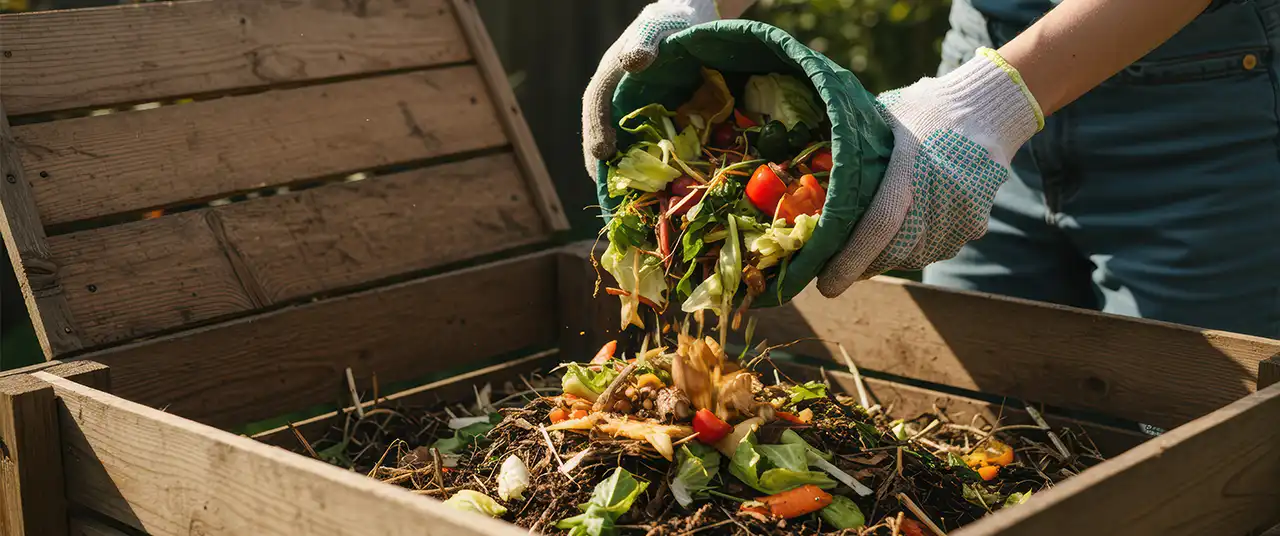
From housing societies, to hospitals, to temples, composting is having its moment in the sun
Editor's Note: In this series, the Good Food Movement explores composting—a climate-friendly, organic way to deal with waste. We answer questions about what you can compost, how to build composting bins and how this process can reshape our relationship with nature and our urban ecosystem.
Every small action we take creates ripples in a larger chain of change—whether it’s rethinking what we eat or how we confront the waste our cooking leaves behind. Too often, that waste becomes someone else’s burden, carted away to landfills in urban and rural spaces alike, already overflowing with trash.
But there’s another way. Through regenerative practice like composting, what seems like waste can be reused and returned to the earth. Even in cramped spaces, all it really takes is a bin and patience. And when people come together, the impact multiplies. From housing societies in Mumbai to individuals inspiring entire communities in Bengaluru, composting has helped turn everyday scraps into rich nourishment for the soil—nurturing potted plants, neighbourhood gardens, and local trees.
Green Garden Apartments, a 73-bungalow community in Chembur in suburban Mumbai once sent 600 kg of mixed waste every month to landfills. In 2018, the apartment complex embraced zero-waste living, segregating waste and composting organic content to produce 100 kg of compost each month. At Silver Crest, Powai, residents process organic waste onsite, using compost for landscaping and donating the surplus to farmers.
In Bengaluru’s Mantri Paradise complex, housekeeping staff now spend a couple of hours each day tending to aerobins that transform used tea leaves, fruit peels, and vegetable scraps into 60 kg of rich, earthy compost. This has led to monthly savings of roughly ₹15,000 on manure purchases and the elimination of foul odours, all thanks to twelve community-installed composters and diligent waste segregation.
Also read: Can composting be the solution to expanding landfills in cities like Bengaluru?
Even the country’s temples are changing their relationship with waste. In Mumbai, the Shree Parleshwar and Mahalakshmi temples pack offerings of marigold and jasmine into boxes of culture mix, producing compost in three weeks. In Tamil Nadu, the Mission Sunehra Kal initiative has 182 temples transforming their floral offerings into rich manure for their own gardens.
Educational institutions are increasingly prioritising waste management as well. Organisations such as the Vivekanand Education Society, Guru Nanak Khalsa College of Arts, Science and Commerce, and Ashoka University, along with several schools and hospitals in cities like Pune and Bengaluru, have launched initiatives to responsibly manage their waste. Hospitals too—such as Cooper Hospital in Mumbai and the Artificial Limb Centre in Pune—have begun composting efforts to handle their waste more sustainably.
Additionally, numerous individuals are experimenting with composting in their own homes and communities, showing that it doesn’t take much to get started. No matter what the scale, their efforts prove that composting can fit into any lifestyle.
After retirement, Rajinder Singh turned to terrace gardening. When his plants initially failed, instead of hiring help, he learned plant care himself. Today, his lush rooftop boasts over 500 plants—fruits, vegetables, and flowers—all nourished by the 100 kg of compost he produces from household waste.
Faced with waste piling up in mounds outside her Khagual home, Kumari embraced a sustainable waste management program in 2017. She began composting kitchen scraps, growing her own produce, and reusing containers. Her leadership inspired 350 households to adopt composting, cutting open dumping by 60% and creating cleaner, safer streets.
Starting small, Sohoni learned how kitchen waste could become a resource. He introduced composting to his 220-unit housing society, converting 72 tonnes of organic waste. In 2017, he founded the Green Communities Foundation, supporting over 220 housing societies and diverting 4,000 tonnes of waste from landfills through aerobic composting.
In Buragunte, a village tucked into the fringes of Sarjapura, under the quiet insistence of Lalitha Akka, a shift began. What if, she asked, the leftovers didn’t have to vanish into some distant, smoking heap? The women in her village brainstormed. They began to pile their kitchen scraps into small pits behind their homes, and weeks later, they harvested compost that they folded back into the fields.
Meanwhile, in the digital sphere, “Worm Rani” has become an Instagram star. With over 300,000 followers, Vani Murthy’s reels demystify composting and sustainable living. From her terrace workshops to speaking about using reusable steel cups, she models a life where composting is less an eco-chore and more a meaningful daily ritual.
Inspired by Worm Rani, composting warrior Anisha Nayak began her own journey from reluctance to triumph. Her balcony, once a storage space, is now home to a terracotta compost setup—later upgraded to a sleek Khamba unit from Daily Dump. Two years later, not a scrap of green waste leaves her home.
Also read: Setting up a compost bin at home: Do’s and don’ts for feed and airflow
From professional waste management companies like Earth5R, DailyDump, Sampurn(e)rth, RUR Greenlife, My Green Bin, and Green Legion, to municipal programs offering composting kits and collection services, help is everywhere.
If you feel intimidated, start small. Pick a composting method that works for your space. Engage with your community. Share your results. Because you’re not alone. And your bin might just inspire your apartment building, your college, your city.
Also read: The science of scraps: How to get composting right
{{quiz}}

Preservative-laden pickles, artificially-flavoured milk drinks—even seemingly harmless foods can be ultra-processed
For as long as we’ve been cooking, humans have been trying to solve one problem: how to keep food from spoiling. Over centuries, we’ve evolved from drying ingredients under the sun to sealing them in factory-made packets. Somewhere between the simple acts of preservation and the crunch of convenience lies the story of altered food.
Step into almost any Indian kitchen and you’ll see food in motion. Rice being rinsed in cloudy water. Milk coaxed into becoming curd with nothing more than a spoonful of yesterday’s batch. These are almost invisible acts of processing—meant to preserve, to prepare, and to make a staple edible without stripping it of its character. Move a little further along the spectrum, and the transformations deepen. Dosa batter fermenting overnight, butter simmered down to ghee, vegetables sliced and left to dry in the sun. Still recognisably food, but reshaped by time and microbes. Push outward, and you reach artisanal processing—commercial blocks of paneer wrapped in cellophane, flour ground and packaged with minimal modification, jars of pickles made to last a season.
And then, at the far end, a rupture: industrial ultra-processing. This is where food is engineered rather than prepared. Instant noodles compressed into bricks, bread puffed up with emulsifiers, curry pastes and ready-to-eat meals fortified with stabilisers and preservatives. Here, salt, sugar, and fat dominate to override satiety and keep you reaching for more. But this was not always the case.
Consider ghee-making—one of humanity's oldest food preservation techniques. Traditional ghee involves slowly heating butter until the water within it evaporates and milk solids separate. This process concentrates nutrients, creates unique flavour compounds, and produces a stable fat that doesn't need refrigeration. In contrast, the manufacture of commercial ghee may start with cheaper oils. It may also contain additives such as butylated hydroxyanisole (BHA) and butylated hydroxytoluene (BHT), added to improve shelf-life, but better known for their debatable health risks if consumed above conservative limits.
Dosa batter fermentation represents another traditional process. When rice and lentils are soaked, ground, and fermented, naturally occurring bacteria and yeast break down proteins and carbohydrates. This increases nutrient bioavailability, creates beneficial compounds like folate, reduces anti-nutrients, and imbues dosa batter with its characteristic tangy flavour. However, instant dosa mixes skip fermentation entirely. The complex biochemical transformations that occur during natural fermentation—which create beneficial compounds and improve digestibility—are bypassed in favour of speed and shelf stability.

Also read: Bastar’s secret ingredient? The power of preservation
Processed foods start as natural or minimally-processed foods but have a few extra ingredients added—like salt, sugar, or oil. They are usually recognisable versions of the original food and are often used in cooking as part of a meal rather than eaten entirely on their own. For example, frozen peas or store-bought plain yogurt.
On the other hand, ultra-processed food often includes substances not typically found in a home kitchen. Its definition continues to evolve, but the generally agreed-upon understanding of the term is any industrial formulation containing five or more ingredients, including stabilisers and preservatives. The food matrix is broken down, meaning nutrients are less intact compared to the original source. Such foods are designed to be hyper-palatable, long-lasting, and ready-to-eat, but look and taste very different from the raw ingredients they came from. Examples: soda, chips, candy bars, flavoured instant noodles, or fruit juice in tetra packs.
India faces a unique challenge: there is no standard criteria for identifying UPFs using a classification system based on the extent and purpose of industrial processing.
If you slice up a potato at home and fry it as chips, it will be considered processed because you start with a natural food (potato), add ingredients like oil and salt, and cook it. The final product is still clearly derived from the original potato, and you’re only using simple ingredients you would normally have in your kitchen. Store-bought packaged chips, however, are ultra-processed since they contain many additives and go through industrial processing methods.
Here are some quick tips to spot the difference between the two categories:
To apply the rule, start by looking at the Nutrition Facts label and focusing on the % Daily Value (% DV) column, which mentions the percentage of your daily diet that the food would contribute to.

India faces a unique challenge: there is no standard criteria for identifying UPFs using a classification system based on the extent and purpose of industrial processing. This definitional gap has led to inconsistent terminology, with descriptors like “junk foods,” “fast foods,” “ready-to-eat foods,” “instant foods,” “processed foods,” “packaged foods,” and “high-fat-sugar-and-salt (HFSS) foods” all being used interchangeably to denote UPFs.
In 2024, researchers in India decided to address this by turning to a more familiar marketplace: the online grocery store. They scanned the labels of 375 brands—at least three for each item—and confirmed 81 foods (including chips, ready-to-serve beverages, breakfast cereals, namkeens, jams, and peanut butter) to be unmistakably ultra-processed. Even some packaged versions of traditional recipes, sold as convenient shortcuts to home cooking, carried the same markers highlighted in the Food and Agriculture Organization’s (FAO) guide to identifying UPFs. The markers included added flavours and colours (to mask unpleasant tastes, smells, or textures caused by ingredients, processing, or packaging), or enhanced the product to make its sensory qualities (appearance, taste, aroma, or feel) more appealing, or both.
The goal is to recognise the difference between processing that enhances food and processing that engineers it beyond recognition.
Twenty-three categories of UPFs emerged from this analysis, revealing clear preference patterns. Breads, chips, and sugar-sweetened beverages topped the list as the most preferred UPFs, while frozen ready-to-cook foods (like chicken nuggets and frozen kebabs) were least preferred—reflecting Indian taste preferences and eating habits.
Commonly consumed, everyday UPFs that many people don't recognise as being ultra-processed include breakfast staples like commercial bread (even the ‘brown’ varieties), packaged cereals, and instant oats with added flavours. The beverages in this segment encompass packaged fruit juices, flavoured milk, and energy drinks. Convenience items, like packets of ketchup and mayonnaise, and seemingly traditional offerings, too, fall into this category—pickles packed with preservatives, commercial chutneys, and packaged spice mixes with anti-caking agents—demonstrating how UPF ingredients have crept into food preparation.
Also read: Food for thought? How our meals and minds are deeply, delicately connected
Indians are purchasing more and more junk food and the health implications are alarming. The Indian Council of Medical Research (ICMR) estimates that 56.4% of India's total disease burden—measured in financial costs, hospitalisation expenses, and lost productivity due to illness, including sick leave from school and work—is directly linked to the rising consumption of junk food.
This shift represents a cultural transformation. Understanding this spectrum helps make informed decisions. The goal is to recognise the difference between processing that enhances food and processing that engineers it beyond recognition.
A good rule of thumb is to look for foods with short, familiar ingredient lists. Whenever possible, choose items that have been traditionally processed. When convenience is unavoidable, take a moment to read the label and select products that stay closest to their original preparation methods. By understanding the difference between beneficial processing and its industrial counterparts, one can make choices that balance health with ease.
Also read: For Odisha’s Chuktia Bhunjias, preservation by drying is tradition—and sustenance
{{quiz}}
Please try another keyword to match the results
